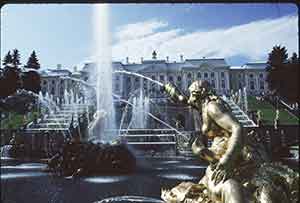St. Petersburg, Helsinki, Tallinn, Stockholm, Oslo, Bergen
July 12-27, 2017 -- $6,699 per person plus air tax.
three cruises -- scenic train rides -- leisurely pace -- small group.
This carefully-planned tour visits the main highlights of St. Petersburg and Scandinavia with a customized itinerary that stays for several nights in each destination. You will have time to soak up the local atmosphere and get to know the place, without being in a big rush. We 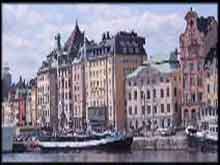 conduct guided tours in each place so you can learn your way around and understand the many fine sights we will be seeing, and you will have free time for personal exploration. The weather in July is very mild, with temperatures expected to be in the 70s. The places we are visiting are generally as far north as Anchorage, Alaska. Daylight lasts until 10:30 p.m., which enables us to fit many activities into our schedule, as you will see in this summary followed by a very detailed story below.
conduct guided tours in each place so you can learn your way around and understand the many fine sights we will be seeing, and you will have free time for personal exploration. The weather in July is very mild, with temperatures expected to be in the 70s. The places we are visiting are generally as far north as Anchorage, Alaska. Daylight lasts until 10:30 p.m., which enables us to fit many activities into our schedule, as you will see in this summary followed by a very detailed story below.
HOTELS -- Compare our approach with a bus tour. -- 32-page pdf tour brochure.
ST. PETERSBURG: Our comprehensive visit to this beautiful city will include tours to the Hermitage Museum, and the Palaces of Catherine and Peter the Great. Each of our four days will feature many planned activities, plus there will be some free time for you to explore your own interests
HELSINKI is the largest city, capital, and chief seaport of Finland. You will find it is a wonderful city for walking, with its stylish shops, open markets, tree-lined promenades, gourmet food halls, and enticing restaurants. We take a day-cruise to Tallinn, Estonia's medieval capital.
STOCKHOLM: we continue our journey with an overnight cruise, heading for Sweden and the cosmopolitan capital of Stockholm, probably the most interesting of all Scandinavian cities. There is more to see and do here than you can ever hope to cover, but we will have three days to keep busy having fun.
-06.jpg) OSLO: Norway’s most important city for 1,000 years, with many museums, parks, spectacular views, restaurants and nightlife. Downtown Oslo is compact, with shops, museums, and historic sights concentrated in a small walkable center—clean, safe, and busy at night with shoppers and strollers.
OSLO: Norway’s most important city for 1,000 years, with many museums, parks, spectacular views, restaurants and nightlife. Downtown Oslo is compact, with shops, museums, and historic sights concentrated in a small walkable center—clean, safe, and busy at night with shoppers and strollers.
BERGEN: We now embark on the final leg of our holiday with a train ride and a spectacular cruise along the rugged fjords of the west coast of Norway to Bergen. We spend two nights in this most charming of coastal towns, surrounded by water, fjords, and mountains.
Watch 5-minute video about the tour:
Detailed Tour Description:
ST. PETERSBURG
 Saint Petersburg is often regarded as one of the world’s most beautiful cities. You will see architecture and art treasures on our visit that will astonish you! Unimaginable splendor was created during the 18th and 19th centuries when the czars ruled with near absolute power over the world’s largest country. All of the wealth of this huge land, which reaches half way around the world, was funneled into the hands of its aristocracy living in St. Petersburg, who spent lavishly to support the royal lifestyle and constructed grand palaces, museums and great public monuments to themselves. These splendid structures were preserved throughout all the turmoil of a century of communist revolution and have been wonderfully renovated to provide some of the world’s richest sights for you to enjoy.
Saint Petersburg is often regarded as one of the world’s most beautiful cities. You will see architecture and art treasures on our visit that will astonish you! Unimaginable splendor was created during the 18th and 19th centuries when the czars ruled with near absolute power over the world’s largest country. All of the wealth of this huge land, which reaches half way around the world, was funneled into the hands of its aristocracy living in St. Petersburg, who spent lavishly to support the royal lifestyle and constructed grand palaces, museums and great public monuments to themselves. These splendid structures were preserved throughout all the turmoil of a century of communist revolution and have been wonderfully renovated to provide some of the world’s richest sights for you to enjoy.
-06.jpg) It all began with Peter the Great, who founded the city in 1703, basing it on the great capitals of Europe. He chose this strategic location where the Neva River joins the Gulf of Finland as the perfect place to build his navy and launch attacks on his enemies to the north. Peter was determined to catapult Russia from the Dark Ages into modern times in a single generation, and he succeeded. Architects and artisans were imported from Western Europe and put to work constructing a glorious new city on what had been empty, swampy, muddy islands. It was the only European capital to be built from scratch on a previously empty patch of land, following a plan.
It all began with Peter the Great, who founded the city in 1703, basing it on the great capitals of Europe. He chose this strategic location where the Neva River joins the Gulf of Finland as the perfect place to build his navy and launch attacks on his enemies to the north. Peter was determined to catapult Russia from the Dark Ages into modern times in a single generation, and he succeeded. Architects and artisans were imported from Western Europe and put to work constructing a glorious new city on what had been empty, swampy, muddy islands. It was the only European capital to be built from scratch on a previously empty patch of land, following a plan.
St. Petersburg continued as the nation’s capital for two centuries, growing ever grander, changing names now and then depending on which way the political wind blew. It became Petrograd, to honor its founder, then Leningrad, and now it’s back to St. Petersburg. Current population is about 5 million, spread over 100 islands that are crisscrossed in all directions by rivers and canals.
Last century’s social dislocations and lack of resources ironically helped to preserve the city’s grand historic architecture, since there was no money for demolition or redevelopment. Now these historic sites are valued as magnets to bring in tourists, so they are kept in very good condition.
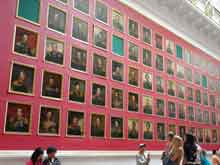 The grandest spectacle of St. Petersburg is the Hermitage Museum, which would take a full day to see, but we will split our visit into two half-days as even the most intrepid art fan can grow numb after too many hours filled with masterpieces. The Hermitage has a splendid collection that includes paintings, statues and decorative arts, while the interior design of the palace itself really is the star of the show, outshining even the great works on display. Other palaces, monuments and interesting shopping neighborhoods will round out our visit.
The grandest spectacle of St. Petersburg is the Hermitage Museum, which would take a full day to see, but we will split our visit into two half-days as even the most intrepid art fan can grow numb after too many hours filled with masterpieces. The Hermitage has a splendid collection that includes paintings, statues and decorative arts, while the interior design of the palace itself really is the star of the show, outshining even the great works on display. Other palaces, monuments and interesting shopping neighborhoods will round out our visit.
 We enjoy a city tour by private bus, and also a boat ride through the canals, with our local guide who will be with us throughout our stay in St. Petersburg. This comprehensive overview of the city passes many of the major monuments and squares, with opportunity to get off the bus now and then to take photos and stretch your legs.
We enjoy a city tour by private bus, and also a boat ride through the canals, with our local guide who will be with us throughout our stay in St. Petersburg. This comprehensive overview of the city passes many of the major monuments and squares, with opportunity to get off the bus now and then to take photos and stretch your legs.
We start out with a visit to Palace Square, at the very epicenter of the history and grandeur of St. Petersburg, with the Winter Palace on one side, containing the Hermitage Museum, and the magnificent General Staff Building of the Army on the other side, with the huge Alexander Column in the middle. This is the world's tallest pillar — the tallest free-standing monument, 154 feet high, commemorating Russia's difficult victory over Napoleon. It is in a grand setting along the Neva River Embankment. Here we board our boat for a peaceful ride through several canals, lined with former palaces and green parks.
-06.jpg) Resuming the bus tour, we stop by two bright red lighthouses that are reminders this was an important port for Russia in previous centuries. Continuing along the Embankment past the Admiralty, we enter Decembrists’ Square, with the great church of St. Isaacs in the center. St. Isaac’s Cathedral is one of Europe’s great buildings, designed in the grand style of the Italian Baroque with Byzantine influences. Its huge dome, which soars 325 feet high, is covered with 200 pounds of gold leaf that sparkles brilliantly in the sun.
Resuming the bus tour, we stop by two bright red lighthouses that are reminders this was an important port for Russia in previous centuries. Continuing along the Embankment past the Admiralty, we enter Decembrists’ Square, with the great church of St. Isaacs in the center. St. Isaac’s Cathedral is one of Europe’s great buildings, designed in the grand style of the Italian Baroque with Byzantine influences. Its huge dome, which soars 325 feet high, is covered with 200 pounds of gold leaf that sparkles brilliantly in the sun.
 We continue our bus tour along Nevsky Prospect, the main street of St. Petersburg, lined with shops and restaurants. Nevsky is the best shopping strip the country has to offer, filled with thousands of residents out for a walk, so it is a fine place for serious spending and people-watching. Here we have free time to walk around and maybe do some shopping.
We continue our bus tour along Nevsky Prospect, the main street of St. Petersburg, lined with shops and restaurants. Nevsky is the best shopping strip the country has to offer, filled with thousands of residents out for a walk, so it is a fine place for serious spending and people-watching. Here we have free time to walk around and maybe do some shopping.
 You will enjoy a stroll into the city’s main mall which occupies a large block in the heart of the Nevsky Prospect. Called the Passage, it is a large department store complex with hundreds of small shops filling two floors of a mammoth structure, catering mostly to local shoppers. It is a fun place to browse and hang out for a while to see what’s up, examine the merchandise and check out the locals. Just over a decade ago these shops had very few items, due to a depressed economy that was tightly controlled by communist bureaucrats — so the merchants have really come a long way. Gostiny Dvor, originally built during the late 18th century to designs by Rastrelli as a merchants arcade called, has been nicely renovated while retaining a historic character that makes it a most unusual department store.
You will enjoy a stroll into the city’s main mall which occupies a large block in the heart of the Nevsky Prospect. Called the Passage, it is a large department store complex with hundreds of small shops filling two floors of a mammoth structure, catering mostly to local shoppers. It is a fun place to browse and hang out for a while to see what’s up, examine the merchandise and check out the locals. Just over a decade ago these shops had very few items, due to a depressed economy that was tightly controlled by communist bureaucrats — so the merchants have really come a long way. Gostiny Dvor, originally built during the late 18th century to designs by Rastrelli as a merchants arcade called, has been nicely renovated while retaining a historic character that makes it a most unusual department store.
-06.jpg) The Church on Spilled Blood is nearby on a canal. This is the most Russian-looking major building in town, with its wild, colorful spires similar to the famous St. Basil in Moscow’s Red Square. It was built in the Russian Revival style as a memorial to Czar Alexander II, who was assassinated here by a terrorist bomb in 1881.
The Church on Spilled Blood is nearby on a canal. This is the most Russian-looking major building in town, with its wild, colorful spires similar to the famous St. Basil in Moscow’s Red Square. It was built in the Russian Revival style as a memorial to Czar Alexander II, who was assassinated here by a terrorist bomb in 1881.
Returning to Nevsky Prospect from the church, you will be facing yet another church, Kazan Cathedral, which looks like a smaller version of St. Peter’s in Rome, with a graceful dome and two long colonnade arms reaching out around the plaza in front.
CATHERINE PALACE
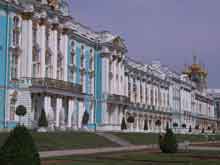
-06.jpg) This afternoon we visit Catherine Palace, one of the most beautiful of all Russia’s royal homes, an hour’s drive outside of town. This stunning place was created by Peter the Great’s daughter, Czarina Elizabeth I, who commissioned her favorite architect, Rastrelli. That same pair were responsible for the two other major palaces we have seen, the Winter Palace, containing the Hermitage, and Peterhof.
This afternoon we visit Catherine Palace, one of the most beautiful of all Russia’s royal homes, an hour’s drive outside of town. This stunning place was created by Peter the Great’s daughter, Czarina Elizabeth I, who commissioned her favorite architect, Rastrelli. That same pair were responsible for the two other major palaces we have seen, the Winter Palace, containing the Hermitage, and Peterhof.
Catherine Palace was later expanded by Catherine the Great into the magnificent structure we see today, helped by the innovative designs of Charles Cameron, a Scot with no previous building experience. While she had many palaces to choose from, this became her favorite residence. Built over two generations, the palace displays a dramatic mix of Baroque and Neoclassical styles. The façade is nearly 1,000 feet long, featuring many muscular statues of Atlas, whose massive shoulders hold up the windows, doors and roofline, flanked by dozens of pilasters and 200 types of stucco ornamentation that complete this amazing architectural scene.
 Inside this museum are 20 rooms restored to their original appearance as well as special exhibition galleries with informative historical displays. The most important room is the Great Hall. The room is long and narrow but gives a feeling of wide spaces because of the illusion created by all the windows and mirrors, while the painted sky in the ceiling adds a sensation of more space to this ballroom. Hundreds of unique Rococo wood carvings on the walls of birds and flowers, with no two images looking alike, extend the space even further. Walls of several rooms are completely covered in precious Chinese silk, with beautiful pictures woven into the threads depicting allegorical landscapes and pleasant floral patterns, with many colorful birds and natural scenes. Matching Asian furniture, vases and decorations enhance the effect.
Inside this museum are 20 rooms restored to their original appearance as well as special exhibition galleries with informative historical displays. The most important room is the Great Hall. The room is long and narrow but gives a feeling of wide spaces because of the illusion created by all the windows and mirrors, while the painted sky in the ceiling adds a sensation of more space to this ballroom. Hundreds of unique Rococo wood carvings on the walls of birds and flowers, with no two images looking alike, extend the space even further. Walls of several rooms are completely covered in precious Chinese silk, with beautiful pictures woven into the threads depicting allegorical landscapes and pleasant floral patterns, with many colorful birds and natural scenes. Matching Asian furniture, vases and decorations enhance the effect.
-04.jpg) When finished, we take a break in the excellent shopping arcade on the ground floor with a dozen different stalls that sell the full range of Russian souvenirs at negotiable prices. There is more to see in the extensive royal gardens, with little duck ponds, rolling lawns, manicured bushes, surprise gazebos and scattered statues, all connected by comfortable gravel pathways.
When finished, we take a break in the excellent shopping arcade on the ground floor with a dozen different stalls that sell the full range of Russian souvenirs at negotiable prices. There is more to see in the extensive royal gardens, with little duck ponds, rolling lawns, manicured bushes, surprise gazebos and scattered statues, all connected by comfortable gravel pathways.
Our private bus brings us back into town where we enjoy a free evening, perhaps enjoying a night out at the ballet.
HERMITAGE
-04.jpg) We start out with a visit to the Hermitage Museum, one of Russia’s most important attractions. This is the world’s largest art museum, with an enormous collection that covers the entire span of art history. There are 15,000 paintings and 12,000 statues, spread through 400 exhibition rooms, spanning an incredible range: from the earliest prehistory into the medieval and Byzantine arts, then the Renaissance, continuing through the Baroque, along with the 18th and 19th centuries, including a fine Impressionist collection, and finally into the 20th century. It also has a wide variety of ancient art, with important pieces from Egypt, Rome and Greece. The extensive Hermitage collection is too big to see in one day, so we cover half today and come back tomorrow for more.
We start out with a visit to the Hermitage Museum, one of Russia’s most important attractions. This is the world’s largest art museum, with an enormous collection that covers the entire span of art history. There are 15,000 paintings and 12,000 statues, spread through 400 exhibition rooms, spanning an incredible range: from the earliest prehistory into the medieval and Byzantine arts, then the Renaissance, continuing through the Baroque, along with the 18th and 19th centuries, including a fine Impressionist collection, and finally into the 20th century. It also has a wide variety of ancient art, with important pieces from Egypt, Rome and Greece. The extensive Hermitage collection is too big to see in one day, so we cover half today and come back tomorrow for more.
-06.jpg) Our expert guide will lead us through, explaining all the significant pieces. We enter through the grandest staircase you have ever seen, filled with beautiful statues, mirrors and golden decorations in the elaborate Baroque style. The Malachite Room is one of the most famous galleries, decorated in semi-precious green malachite stone. Pavilion Hall, used mostly for entertaining, has a breathtaking white marble design with lots of gold ornamentation. The Impressionists are a special treat, with excellent works by all your favorites: Monet, Manet, Renoir, Pissaro, Cezanne, Van Gogh and Gaughin. There is also a nice selection of more modern canvases by Leger, Kandinsky, Picasso and 37 paintings by Matisse, Europe’s largest collection of his works. After walking through more elaborate rooms of the private apartments of the czar, we shall save the rest for tomorrow.
Our expert guide will lead us through, explaining all the significant pieces. We enter through the grandest staircase you have ever seen, filled with beautiful statues, mirrors and golden decorations in the elaborate Baroque style. The Malachite Room is one of the most famous galleries, decorated in semi-precious green malachite stone. Pavilion Hall, used mostly for entertaining, has a breathtaking white marble design with lots of gold ornamentation. The Impressionists are a special treat, with excellent works by all your favorites: Monet, Manet, Renoir, Pissaro, Cezanne, Van Gogh and Gaughin. There is also a nice selection of more modern canvases by Leger, Kandinsky, Picasso and 37 paintings by Matisse, Europe’s largest collection of his works. After walking through more elaborate rooms of the private apartments of the czar, we shall save the rest for tomorrow.

-04.jpg) This afternoon is free time for us to explore the central shopping and retail district of St. Petersburg along Nevsky Prospect, around the corner from our hotel.
This afternoon is free time for us to explore the central shopping and retail district of St. Petersburg along Nevsky Prospect, around the corner from our hotel.
This morning we complete our visit to the Hermitage, starting with the Italian collection, which holds some of the museum’s greatest treasures, including Renaissance masterpieces by Raphael, Perugino, Botticelli, Fra Angelico, two paintings by Leonardo da Vinci and Russia’s only Michelangelo. Several rooms of Baroque art of the 18th century include Russia’s only canvas by Caravaggio, “The Lute Player” and 26 major works by Rembrandt. Nearby is a room filled with armor, featuring medieval knights sitting on horseback. The Spanish section is considered to be one of the richest in the world, perhaps second only to the Prado in Madrid. A large ensemble of Rubens, Hals and Van Dyck fills the Flemish department.
-06.jpg) We finish our visit downstairs among the ancient statues from Greece, Rome and Egypt. You will find the Hermitage is an entire intact palace filled with treasure, wrapped in an amazingly decorated package. Every place you turn there is something marvelous to look at. Too much art can make the head spin, so it’s a good thing you broke it into two days, and that there are benches scattered throughout the rooms so we can sit down to rest while processing this visual bombardment. What a museum!
We finish our visit downstairs among the ancient statues from Greece, Rome and Egypt. You will find the Hermitage is an entire intact palace filled with treasure, wrapped in an amazingly decorated package. Every place you turn there is something marvelous to look at. Too much art can make the head spin, so it’s a good thing you broke it into two days, and that there are benches scattered throughout the rooms so we can sit down to rest while processing this visual bombardment. What a museum!
PETERHOF and the GOLDEN CASCADE
 This afternoon is a perfect time to visit Peterhof, a spectacular palace in the suburbs. We get there on a fast, comfortable hydrofoil boat that brings us along with our local guide. Considered to be the most beautiful park in Russia, Peterhof was the main home of Peter the Great.
This afternoon is a perfect time to visit Peterhof, a spectacular palace in the suburbs. We get there on a fast, comfortable hydrofoil boat that brings us along with our local guide. Considered to be the most beautiful park in Russia, Peterhof was the main home of Peter the Great.
 The most spectacular feature of the palace is the Golden Cascade, which just might be the world’s most wonderful fountain! It has dozens of golden statues drenched in a huge water display that celebrates one of the most important events in Russian history — the defeat of Sweden in the early 18th century.
The most spectacular feature of the palace is the Golden Cascade, which just might be the world’s most wonderful fountain! It has dozens of golden statues drenched in a huge water display that celebrates one of the most important events in Russian history — the defeat of Sweden in the early 18th century.
Also known as Petrodvorets, this was the first major palace complex constructed in St. Petersburg. A massive construction project began that would finally finish 200 years later, but during Peter’s lifetime the early versions of the Great Palace and fountains were opened. There are many beautiful sections of this park to admire, with formal gardens stretching hundreds of yards towards the Gulf of Finland, sprinkled with statues and smaller fountains on both sides of the palace. The gardens are laid out in a formal French style with neatly trimmed bushes arranged with regular symmetry along straight paths. When driving from the palace back into town at the end of our tour, we pass through some pleasant wooded areas in the countryside sprinkled with small villages and farm plots.
EVENING ACTIVITIES
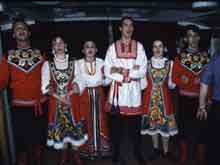 Ballet, and more ballet. Take advantage of the marvelous Russian dancers and go the Mariinskiy Theater for a superb evening of sensual entertainment provided by the world-famous Kirov Ballet. Don’t worry if you have never been to a ballet, or went once and didn’t care for it -- these performances are accessible to everyone. The colorful costumes and beautiful sets in this majestic theater provide a dazzling environment for the magic of the dance, accompanied by a live orchestra. We will organize this optional activity with reserved tickets and private bus transfer, so that the evening will be very easy and most enjoyable. [back to top]
Ballet, and more ballet. Take advantage of the marvelous Russian dancers and go the Mariinskiy Theater for a superb evening of sensual entertainment provided by the world-famous Kirov Ballet. Don’t worry if you have never been to a ballet, or went once and didn’t care for it -- these performances are accessible to everyone. The colorful costumes and beautiful sets in this majestic theater provide a dazzling environment for the magic of the dance, accompanied by a live orchestra. We will organize this optional activity with reserved tickets and private bus transfer, so that the evening will be very easy and most enjoyable. [back to top]
HELSINKI
We take the train from St. Petersburg to Helsinki, through beautiful natural countryside, enjoying the fine comforts of the excellent rail service, which includes a lovely dining car.
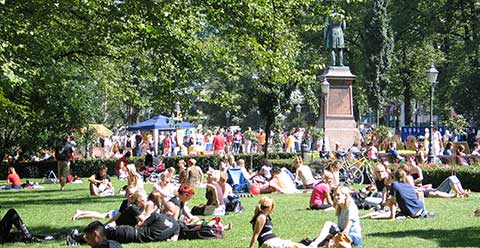 Continental Europe’s most northern and remote capital city is an under-appreciated gem that will surprise you with its beautiful people and attractions. This efficient and thoroughly entertaining city is clean and green, with parks, cafes, museums, shops of all kinds and a picturesque little harbor lined with excursion boats and a bustling waterfront market.
Continental Europe’s most northern and remote capital city is an under-appreciated gem that will surprise you with its beautiful people and attractions. This efficient and thoroughly entertaining city is clean and green, with parks, cafes, museums, shops of all kinds and a picturesque little harbor lined with excursion boats and a bustling waterfront market.
Helsinki is a city of fine design with nicely-planned neighborhoods that function efficiently. Founded relatively late by European standards in the 17th century and designated as capital in 1812, the small town was initially built of wood and burned down several times, so nearly all the buildings we see today are no more than 200 years old. The nation is also quite young, achieving its independence only in 1917 after a century of occupation by Russia and 650 years of control by Sweden. .jpg)
Helsinki’s modern town planners have done an excellent job of creating a livable city praised by the Harvard Architectural Digest as the “Best Designed City in Europe.” The familiar European pattern is here: a compact city with most residents living in apartment buildings located near shops and offices and served by mass transit to efficiently move people around without causing major traffic jams. This is a small capital with just 500,000 residents, but there is an underground metro system and numerous light rail trams running on the surface along the main streets. This transit system will help us get around in our visit. Because of the compact urban center, it is very easy for us to see most of the sights on foot.
.jpg) July is an excellent time to visit because the weather is at its best and the city is not crowded, for many locals leave on vacation then. Temperatures are mild, usually in the 70s, because Helsinki is so far north, nearly as high as Anchorage, Alaska, and the days have 20 hours of sunshine. There will still be plenty of locals in town for you to mingle with if you choose: most are friendly, fluent in English and they spend a lot of time outdoors on the streets, cafes and parks, enjoying the fleeting good weather.
July is an excellent time to visit because the weather is at its best and the city is not crowded, for many locals leave on vacation then. Temperatures are mild, usually in the 70s, because Helsinki is so far north, nearly as high as Anchorage, Alaska, and the days have 20 hours of sunshine. There will still be plenty of locals in town for you to mingle with if you choose: most are friendly, fluent in English and they spend a lot of time outdoors on the streets, cafes and parks, enjoying the fleeting good weather.
.jpg) We arrive in the afternoon, which gives us time for an orientation walking tour. A great place to start our explorations is at Market Square, the colorful outdoor food market next to the harbor. This is only a few blocks from our hotel. Here we will find all sorts of fresh produce and prepared foods ready to eat, along with some booths selling souvenirs and crafts. The air is fresh with sea breezes and the music of seagulls accompanying the sounds of the merchants hawking their goods. This harbor scene is so fascinating that you will probably come back again.
We arrive in the afternoon, which gives us time for an orientation walking tour. A great place to start our explorations is at Market Square, the colorful outdoor food market next to the harbor. This is only a few blocks from our hotel. Here we will find all sorts of fresh produce and prepared foods ready to eat, along with some booths selling souvenirs and crafts. The air is fresh with sea breezes and the music of seagulls accompanying the sounds of the merchants hawking their goods. This harbor scene is so fascinating that you will probably come back again.
-(5).jpg) Numerous excursion boats are docked here, offering a variety of enticing itineraries including lunch and dinner cruises, or a choice of several 90-minute sightseeing voyages along the city’s shores and through the nearby archipelago. Have a look at the various cruise posters and brochures and select one for later, making note of departure times to help plan your schedule.
Numerous excursion boats are docked here, offering a variety of enticing itineraries including lunch and dinner cruises, or a choice of several 90-minute sightseeing voyages along the city’s shores and through the nearby archipelago. Have a look at the various cruise posters and brochures and select one for later, making note of departure times to help plan your schedule.
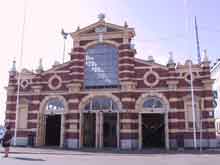 Another wonderful marketplace at the harbor is found in The Old Market Hall, which has been a favorite hangout of foodies for 110 years. This beautiful old building has two long shopping aisles lined on both side with thirty merchants selling a nice variety of foods ranging from pastry snacks to ingredients for a gourmet meal. You can sit down for lunch at one of the snack bars or purchase foods to go: cheese, coffee, fish, chocolate, meats, spices, fruits, vegetables and alcohol. There is lots more to discover in the many stalls, including sushi and smoked reindeer meat.
Another wonderful marketplace at the harbor is found in The Old Market Hall, which has been a favorite hangout of foodies for 110 years. This beautiful old building has two long shopping aisles lined on both side with thirty merchants selling a nice variety of foods ranging from pastry snacks to ingredients for a gourmet meal. You can sit down for lunch at one of the snack bars or purchase foods to go: cheese, coffee, fish, chocolate, meats, spices, fruits, vegetables and alcohol. There is lots more to discover in the many stalls, including sushi and smoked reindeer meat.
After you’ve had enough of the market and harbor, begin your walking explorations of the rest of town. From here we walk towards the heart of town, heading for the green park just beyond the large bronze fountain of the Havis Amanda, the mermaid symbol of Helsinki.
ESPLANADE
 The most popular park in town, called the Esplanade (they say “Esplanadi”) runs through the middle of downtown from the waterfront to the main commercial street of town, Mannerheimintie, just three blocks away. This is very much the heart of town and a place most visitors come back to several times to relax, shop, sip and catch some entertainment at the bandstand in the middle of the park. There is a fashionable café in the park, called Kappeli, with a nice range of dining options and special beer brewed on the premises. You can sit outdoors and snack at their large terrace café, or relax inside with a sophisticated meal. This lovely old restaurant was built in the 19th century in an Art Nouveau, solarium style, with large glass walls, potted plants and elaborate interior decor. It was a major hangout for artists and is now a big favorite with the young crowd.
The most popular park in town, called the Esplanade (they say “Esplanadi”) runs through the middle of downtown from the waterfront to the main commercial street of town, Mannerheimintie, just three blocks away. This is very much the heart of town and a place most visitors come back to several times to relax, shop, sip and catch some entertainment at the bandstand in the middle of the park. There is a fashionable café in the park, called Kappeli, with a nice range of dining options and special beer brewed on the premises. You can sit outdoors and snack at their large terrace café, or relax inside with a sophisticated meal. This lovely old restaurant was built in the 19th century in an Art Nouveau, solarium style, with large glass walls, potted plants and elaborate interior decor. It was a major hangout for artists and is now a big favorite with the young crowd.(04).jpg)
Two streets on each side of the Esplanade host the main concentration of stores selling Finnish goods, such as Marimekko fabrics, Aarika wooden jewelry and gifts, Hackman Arabia porcelain and Artek furniture. Especially along North Esplanade, these shops are all noted for their world-famous Finnish designs, with a sleek, modern, functionalist look. The Finns are proud to be a major creative force in the development of the Scandinavian design movement, whose roots stretch back to the Art Nouveaux movement of the early 1900s and have continued evolving into our post-modern world. Several excellent restaurants are also found along both sides of the park.
CITY CENTER
.jpg) The main shopping district of Helsinki is found in a compact area between the Esplanade and the train station, just four blocks square with the large department store, Stockmann, in the center. Department stores are open from 9:00am to 9:00pm, while the malls and smaller shops close one hour earlier. The two most important shopping streets, Mannerheimintie and Aleksanterinkatu intersect at Stockmann, forming a busy little plaza called Three Blacksmiths Square.
The main shopping district of Helsinki is found in a compact area between the Esplanade and the train station, just four blocks square with the large department store, Stockmann, in the center. Department stores are open from 9:00am to 9:00pm, while the malls and smaller shops close one hour earlier. The two most important shopping streets, Mannerheimintie and Aleksanterinkatu intersect at Stockmann, forming a busy little plaza called Three Blacksmiths Square.-(5).jpg) Trams run along both of these main streets making it very easy to get here from anywhere in the city, but once you are in this zone you merely need to stroll a few blocks to cover all the possibilities. This is the epicenter of Helsinki, so of course it is filled with a lively outdoor café and surrounded by people in motion. Two blocks further along Mannerheimintie is the second largest department store of Helsinki, Sokos. The Forum, the largest mall in town, is across the street with 125 stores. Of course, there are many places to eat and drink in this shopping zone, ranging from inexpensive take-outs (yes, it is possible to eat cheaply here) to high-end, gourmet dining.
Trams run along both of these main streets making it very easy to get here from anywhere in the city, but once you are in this zone you merely need to stroll a few blocks to cover all the possibilities. This is the epicenter of Helsinki, so of course it is filled with a lively outdoor café and surrounded by people in motion. Two blocks further along Mannerheimintie is the second largest department store of Helsinki, Sokos. The Forum, the largest mall in town, is across the street with 125 stores. Of course, there are many places to eat and drink in this shopping zone, ranging from inexpensive take-outs (yes, it is possible to eat cheaply here) to high-end, gourmet dining.
 There is one more highlight for today: Helsinki’s only “skyscraper,” the Torni Tower, with a roof-top observation deck on the twelfth floor that looks out over the city. The Torni welcomes the public up to the rooftop Vista Bar, from which you can see the whole city. This overview will help you look forward to tomorrow’s continued exploration of downtown.
There is one more highlight for today: Helsinki’s only “skyscraper,” the Torni Tower, with a roof-top observation deck on the twelfth floor that looks out over the city. The Torni welcomes the public up to the rooftop Vista Bar, from which you can see the whole city. This overview will help you look forward to tomorrow’s continued exploration of downtown.
 Market Square comes alive by 7:00am, so we can have another look at the busy morning market and perhaps purchase some fresh fruits for later. We walk one block over to Senate Square, the main ceremonial center of town, dominated by Helsinki’s famous Cathedral, which sits majestically on a small hill. In the center of the plaza stands a noble statue of Czar Alexander II, serving as a reminder of Finland’s occupation by Imperial Russia from 1809 to 1917.
Market Square comes alive by 7:00am, so we can have another look at the busy morning market and perhaps purchase some fresh fruits for later. We walk one block over to Senate Square, the main ceremonial center of town, dominated by Helsinki’s famous Cathedral, which sits majestically on a small hill. In the center of the plaza stands a noble statue of Czar Alexander II, serving as a reminder of Finland’s occupation by Imperial Russia from 1809 to 1917.
Alexander wanted Helsinki to look like St. Petersburg, Russia’s capital at that time and just a few hundred miles to the east, so during the 1830s he sent Carl Engel, an eminent German architect, to design the Lutheran Cathedral and surrounding buildings. Finnish architecture, as a result, has many similarities with the Russian style that we have already seen, particularly in the use of neoclassical columns in the ancient Greek manner. .jpg)
The similarities are so convincing that numerous American movies, such as “Reds,” “Gorky Park,” “Dr. Zhivago” and “White Nights,” were filmed in the area around the Cathedral during the communist era when filmmakers could not go to the Soviet Union, and therefore used the Senate Square as a stand-in for Moscow or St. Petersburg. Leaving Senate Square, we walk a block to the Helsinki City Museum, the second most-popular museum in the city. Separate display areas dramatically illustrate the three eras of the city: the Swedish, Russian and independent Finnish.
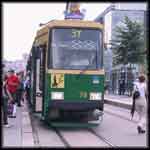 There are some fun, alternative ways to get around that could replace or supplement the bus tour. An easy way to see Helsinki’s sights is by hopping aboard the 3T tram. This route is perfect for tourists as it passes by the Finlandia Hall, Parliament House, National Opera and Senate Square. You can get off the tram at any stop, or you can do the whole loop in one hour.
There are some fun, alternative ways to get around that could replace or supplement the bus tour. An easy way to see Helsinki’s sights is by hopping aboard the 3T tram. This route is perfect for tourists as it passes by the Finlandia Hall, Parliament House, National Opera and Senate Square. You can get off the tram at any stop, or you can do the whole loop in one hour.
You won’tget lost because the tram runs in a figure-8 loop through the center of the city and takes you right back to where you boarded it. For a slightly different sightseeing tour, try Spårakoff, a restored tram that serves as a moving restaurant, allowing you to enjoy Helsinki’s sights while sipping a beer! A sightseeing tour in a boat from Market Square is another fine way to see this maritime city.
.jpg)
.jpg) We will make a stop at the Sibelius Monument so that you can stretch your legs and get a close look. This remarkable modern sculpture is made of 600 tall pipes representing an organ and symbolizing the music of this great native composer, Jean Sibelius, who is probably the world's most famous Finn. When it was first unveiled in 1967 the public disliked the abstract quality of the pipes, and the sculptor was compelled to add a portrait bust of Sibelius, which looks pensively upon the scene. Be sure to walk underneath the pipes and look up into them while you are moving along for a delightfully dizzying involvement with this magnificent ensemble.
We will make a stop at the Sibelius Monument so that you can stretch your legs and get a close look. This remarkable modern sculpture is made of 600 tall pipes representing an organ and symbolizing the music of this great native composer, Jean Sibelius, who is probably the world's most famous Finn. When it was first unveiled in 1967 the public disliked the abstract quality of the pipes, and the sculptor was compelled to add a portrait bust of Sibelius, which looks pensively upon the scene. Be sure to walk underneath the pipes and look up into them while you are moving along for a delightfully dizzying involvement with this magnificent ensemble.
.jpg) We also stop at Temppeliaukio Church, one of Helsinki's most popular attractions, commonly called the Church in the Rocks. It is a stunning amphitheater carved out of natural bedrock, with interior walls of rugged natural stone and a domed ceiling made from copper and glass.
We also stop at Temppeliaukio Church, one of Helsinki's most popular attractions, commonly called the Church in the Rocks. It is a stunning amphitheater carved out of natural bedrock, with interior walls of rugged natural stone and a domed ceiling made from copper and glass.
After the tram tour you are free for the rest of the day. You should consider visiting another one of the city’s top museums which are clustered in the downtown area. It is simply amazing that Helsinki, a small city of 500,000, has 70 museums, many of which also have attractive cafés and gift shops.
Finnish National Museum: Standing exhibitions of the history of Finns, from prehistory to modern times. The museum's exhibits are the result of over 170 years of collecting and are presented in a very educational and entertaining way. This is the top choice for anyone who is interested in culture and history.
.jpg) Kiasma, Museum of Contemporary Art: Some of the world's most radical new buildings in recent years have been museums of contemporary art, and this daring new structure succeeds as one of the most innovative yet. Designed by an American, Stephen Hall, from New York, it looks super-minimalist on the outside, with solid walls shaped into odd geometric blocks, while on the inside the unusual floor plan is both disorientating and easy to navigate, turning your visit into a fun adventure. It has instantly become the most popular museum in the country, with 227,000 annual visitors. The Kiasma collection includes art from the 1960s onwards, featuring changing exhibitions of paintings, space art, photographs, media art and sculpture. [back to top]
Kiasma, Museum of Contemporary Art: Some of the world's most radical new buildings in recent years have been museums of contemporary art, and this daring new structure succeeds as one of the most innovative yet. Designed by an American, Stephen Hall, from New York, it looks super-minimalist on the outside, with solid walls shaped into odd geometric blocks, while on the inside the unusual floor plan is both disorientating and easy to navigate, turning your visit into a fun adventure. It has instantly become the most popular museum in the country, with 227,000 annual visitors. The Kiasma collection includes art from the 1960s onwards, featuring changing exhibitions of paintings, space art, photographs, media art and sculpture. [back to top]
TOUR TO TALLINN:
After staying in Helsinki for a couple of days we are today making a trip across the Baltic Sea to Tallinn, the capital of Estonia. We will be going on fast ferry, which is actually a big ship, like a cruise ship, with several comfortable lounges on board and a couple of restaurants. You can even rent a cabin for the short trip if you'd like to stretch out and relax. There is an outdoor promenade so you can take a stroll on deck, take in the sea views and get some fresh air if you like.
 The journey takes about two hours in a smooth crossing, and before we know it, the time has flown by and we arrive in the port of Tallinn. We deposit our luggage in a storage room at the dock and walk the short distance over to the old town of Tallinn. We shall spend about six hours exploring the old town, some of this with a local guide who takes us on a walking tour, along with some free time for lunch and personal explorations.
The journey takes about two hours in a smooth crossing, and before we know it, the time has flown by and we arrive in the port of Tallinn. We deposit our luggage in a storage room at the dock and walk the short distance over to the old town of Tallinn. We shall spend about six hours exploring the old town, some of this with a local guide who takes us on a walking tour, along with some free time for lunch and personal explorations.
 Tallinn has always been the most important city and capital of Estonia, and recently was recognized by UNESCO as a World Heritage Site. This historic designation is always a very special honor, but in the case of Tallinn it's even more incredible because of what the UNESCO had to say about this town: "Tallinn is the best-preserved medieval town in northern Europe.
Tallinn has always been the most important city and capital of Estonia, and recently was recognized by UNESCO as a World Heritage Site. This historic designation is always a very special honor, but in the case of Tallinn it's even more incredible because of what the UNESCO had to say about this town: "Tallinn is the best-preserved medieval town in northern Europe.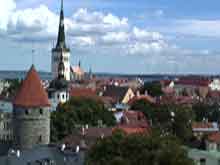 (Tallinn is) a uique example of the coexistence of a seat of feudal landlords and a Hanseatic center in the shelter of a common system of walls and fortifications; an ensemble of mostly authentic buildings constituting an urban structure formed in the 13th and 14th centuries; a radial steel network, town wall, monastic ensembles and a characteristic skyline visible from a great distance on the sea…The Castle and the Hanseatic town of Tallinn were, in the 13th through 16th centuries, among the remotest and most powerful outposts of civilization in the northeastern part Europe. It is a well-preserved ensemble in the chain of trading towns on the Baltic seacoast."
(Tallinn is) a uique example of the coexistence of a seat of feudal landlords and a Hanseatic center in the shelter of a common system of walls and fortifications; an ensemble of mostly authentic buildings constituting an urban structure formed in the 13th and 14th centuries; a radial steel network, town wall, monastic ensembles and a characteristic skyline visible from a great distance on the sea…The Castle and the Hanseatic town of Tallinn were, in the 13th through 16th centuries, among the remotest and most powerful outposts of civilization in the northeastern part Europe. It is a well-preserved ensemble in the chain of trading towns on the Baltic seacoast."
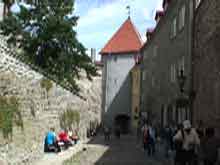 UNESCO goes on to explain that, while there are other important medieval towns in the Baltic area, such as Riga and Visby, those are not as well preserved as Tallinn. Perhaps it was some sort of a quirk of history. At any rate Tallinn is standing today as a great example of medieval architecture and medieval life.
UNESCO goes on to explain that, while there are other important medieval towns in the Baltic area, such as Riga and Visby, those are not as well preserved as Tallinn. Perhaps it was some sort of a quirk of history. At any rate Tallinn is standing today as a great example of medieval architecture and medieval life.
 One of the reasons is that Tallinn's Old Town was projected from modernization because it was occupied and controlled by the Soviets for much of the 20th century. Russian communism never really did much damage here. They didn't have much money to knock down old buildings and put up new ones, and so because of that Tallinn was just left alone, perhaps even neglected, but fortunately for us and for the people of Estonia, it survived as a great symbol of their national pride.
Tallinn is not a highly touristic town. Similar places come to mind, which are generally more crowded and expensive, such as Prague, also a beautiful medieval town but more "discovered." Tallinn is further away from the normal track of mass tourism. After all, we are at the northern fringe of Europe. Estonia is not right next to any other major tourist countries. It's up in the Baltics by Lithuania, Latvia, and across the Baltic Sea from Finland, which is where we came from to enjoy this visit. So Tallinn is a relatively untouched gem and very much worth visiting.
One of the reasons is that Tallinn's Old Town was projected from modernization because it was occupied and controlled by the Soviets for much of the 20th century. Russian communism never really did much damage here. They didn't have much money to knock down old buildings and put up new ones, and so because of that Tallinn was just left alone, perhaps even neglected, but fortunately for us and for the people of Estonia, it survived as a great symbol of their national pride.
Tallinn is not a highly touristic town. Similar places come to mind, which are generally more crowded and expensive, such as Prague, also a beautiful medieval town but more "discovered." Tallinn is further away from the normal track of mass tourism. After all, we are at the northern fringe of Europe. Estonia is not right next to any other major tourist countries. It's up in the Baltics by Lithuania, Latvia, and across the Baltic Sea from Finland, which is where we came from to enjoy this visit. So Tallinn is a relatively untouched gem and very much worth visiting.
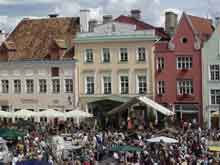 We will discover Tallinn on a private walking tour, so come along as we explore these wonderful streets of the old city. Most of the buildings date back to the 13th century 14th and 15th centuries and some a bit later, to the Renaissance and the Baroque. It can get busy but it's not too crowded – Tallinn hasn't quite been discovered yet by the hordes of tourists. As you walk along and look down side lanes, you occasionally see parts of the medieval wall – another reminder of the antiquity of this town we are walking through.
We will discover Tallinn on a private walking tour, so come along as we explore these wonderful streets of the old city. Most of the buildings date back to the 13th century 14th and 15th centuries and some a bit later, to the Renaissance and the Baroque. It can get busy but it's not too crowded – Tallinn hasn't quite been discovered yet by the hordes of tourists. As you walk along and look down side lanes, you occasionally see parts of the medieval wall – another reminder of the antiquity of this town we are walking through.
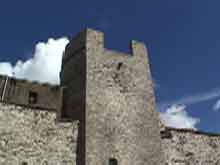 Tallinn is really quite easy to see in a day because it is not all that large: the historic town center is about one square-mile, containing approximately 500 building complexes. All of the old buildings are very well preserved, and many of the streets are for pedestrians. There are signs to help you find your directions should you momentarily get lost, and there's a helpful Tourist Information office in the center with brochures and maps.
Tallinn is really quite easy to see in a day because it is not all that large: the historic town center is about one square-mile, containing approximately 500 building complexes. All of the old buildings are very well preserved, and many of the streets are for pedestrians. There are signs to help you find your directions should you momentarily get lost, and there's a helpful Tourist Information office in the center with brochures and maps.
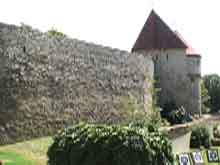 After the ten-minute walk from the dock we enter through a quiet back gate in the fortification wall that encircles the Old Town. As we stroll we notice the little side streets lined with old buildings, which transport us back in time many centuries. We can have a look inside the great Guildhall, a small, free museum that was once the merchant headquarters for the entire region.
After the ten-minute walk from the dock we enter through a quiet back gate in the fortification wall that encircles the Old Town. As we stroll we notice the little side streets lined with old buildings, which transport us back in time many centuries. We can have a look inside the great Guildhall, a small, free museum that was once the merchant headquarters for the entire region.
 Tallinn is divided into a lower town and the upper town, and we shall explore both in our visit. It certainly helps to have a local guide explaining the history to us while we are looking at the buildings, so that we can really understand these marvelous sites in this unique place. The upper part was primarily for the nobles, the upper class who ran the society. It was like a large castle: there was a wall around the upper section creating in effect, a separate town altogether. A focal point up there is Castle Square: the Estonian parliament is behind the beautiful pink Palace on one side of the square, and on the other side there is a large Orthodox Church in the Russian style, reminding us of the Soviet influence over this place.
Tallinn is divided into a lower town and the upper town, and we shall explore both in our visit. It certainly helps to have a local guide explaining the history to us while we are looking at the buildings, so that we can really understand these marvelous sites in this unique place. The upper part was primarily for the nobles, the upper class who ran the society. It was like a large castle: there was a wall around the upper section creating in effect, a separate town altogether. A focal point up there is Castle Square: the Estonian parliament is behind the beautiful pink Palace on one side of the square, and on the other side there is a large Orthodox Church in the Russian style, reminding us of the Soviet influence over this place.
 We reach a spectacular viewpoint from which we see the red tile roofs and encircling wall with it tall towers. There are 26 medieval towers still standing along the wall, which is very well preserved and still standing for nearly its entire length. This wall is a remarkable example of medieval preservation, which you can climb up and walk along during your free time in the afternoon.
We reach a spectacular viewpoint from which we see the red tile roofs and encircling wall with it tall towers. There are 26 medieval towers still standing along the wall, which is very well preserved and still standing for nearly its entire length. This wall is a remarkable example of medieval preservation, which you can climb up and walk along during your free time in the afternoon.
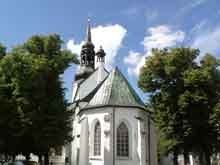 Our walk in the upper town will bring us by various noble structures that had been palaces. Of course there is a variety of architecture, but you don't find new buildings anywhere in the old town. Those medieval merchants of the lower town didn't have it so bad at all. The town was a beautifully functioning medieval city, providing a safe and comfortable place to live.
Our walk in the upper town will bring us by various noble structures that had been palaces. Of course there is a variety of architecture, but you don't find new buildings anywhere in the old town. Those medieval merchants of the lower town didn't have it so bad at all. The town was a beautifully functioning medieval city, providing a safe and comfortable place to live.
 The Danish King's Garden marks the boundary of the upper town, or the Castle, and the lower town. You can clearly see how this was a divided community, separated by class and location, with the aristocrats living up above and the merchants living down below. After walking back downhill to the lower town using the helpful staircase, we'll continue together another couple blocks to the Old Town Square, centerpiece of the old town. Then there will be a few hours of free time for shopping, lunch and individual exploration.
The Danish King's Garden marks the boundary of the upper town, or the Castle, and the lower town. You can clearly see how this was a divided community, separated by class and location, with the aristocrats living up above and the merchants living down below. After walking back downhill to the lower town using the helpful staircase, we'll continue together another couple blocks to the Old Town Square, centerpiece of the old town. Then there will be a few hours of free time for shopping, lunch and individual exploration.
 It is often a challenge in our travels to purchase something locally made, let alone handmade, but here you will find authentic crafts in abundance. One street along the inner side of the wall, has a series of outdoor stalls with beautiful collections of handmade sweaters, all made in Estonia.
It is often a challenge in our travels to purchase something locally made, let alone handmade, but here you will find authentic crafts in abundance. One street along the inner side of the wall, has a series of outdoor stalls with beautiful collections of handmade sweaters, all made in Estonia.
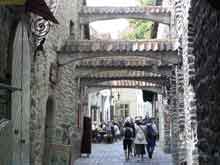 St. Catherine's passage is another one of those perfect medieval spots, yet kind of hidden away as a small pedestrian alley between a couple of other lanes. You might miss it altogether if you didn't have your guide or some kind of helpful instruction. The workshops in this passage are fun: they've got pottery, glass, textiles, woodworking, with a whole variety of things for sale, and you can purchase them directly from the craftsmen who made them. This passage is a classic example of the medieval alley, with stone support beams and arches holding up buildings and protecting them, keeping them standing for all these centuries.
St. Catherine's passage is another one of those perfect medieval spots, yet kind of hidden away as a small pedestrian alley between a couple of other lanes. You might miss it altogether if you didn't have your guide or some kind of helpful instruction. The workshops in this passage are fun: they've got pottery, glass, textiles, woodworking, with a whole variety of things for sale, and you can purchase them directly from the craftsmen who made them. This passage is a classic example of the medieval alley, with stone support beams and arches holding up buildings and protecting them, keeping them standing for all these centuries.
 It seems like all roads lead back to the main town square, where we might get lucky with an outdoor craft fair that happens pretty often in the summertime. It's just perfect moment to be traveling. We can have a nice meal around the corner in Olde Hansa, a famous restaurant offering an outdoor terrace or dark, medieval interior and delicious food at a reasonable price, with friendly service.
It seems like all roads lead back to the main town square, where we might get lucky with an outdoor craft fair that happens pretty often in the summertime. It's just perfect moment to be traveling. We can have a nice meal around the corner in Olde Hansa, a famous restaurant offering an outdoor terrace or dark, medieval interior and delicious food at a reasonable price, with friendly service.
Traveling in the month of July we can expect the temperatures to be in the upper 70s lower 80s, providing comfortable conditions. There is usually a beautiful blue sky with white fluffy clouds and little chance of rain. Estonia is quite far north, so it doesn't usually get hot in July. Of course it would be a lot colder in the wintertime, so you probably don't want to come at that time a year but spring, summer and fall are all wonderful.
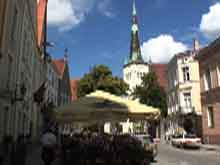 Estonia is a really modern society despite the medieval appearance of Tallinn's Old Town, so don't let the buildings and costumes fool you. These are modern European peoples, very technologically advanced. For example, they've got some of the highest rate of Internet connections and broadband speeds, and a couple of Estonian inventors created Skype software for making free long-distance, computer phone calls. Many other technological innovations have come out of Estonia, in part due to their very high level of education, and strong economy. There is a modern city, with high-rises and shopping malls adjacent to the Old Town, but we can skip that.
They've always been traders – it's appropriate that the town square is often filled with outdoor merchants. This is been going on for more than 700 years in Tallinn – after all it was founded as a merchant town as part of the on the Hanseatic League, which was that northern European medieval alliance of German and Scandinavian merchant centers training with the rest of Europe, bringing goods north and being the middleman, always taking a cut of the profits – still happening today. It's really one of the prettiest town squares that you'll ever see.
Estonia is a really modern society despite the medieval appearance of Tallinn's Old Town, so don't let the buildings and costumes fool you. These are modern European peoples, very technologically advanced. For example, they've got some of the highest rate of Internet connections and broadband speeds, and a couple of Estonian inventors created Skype software for making free long-distance, computer phone calls. Many other technological innovations have come out of Estonia, in part due to their very high level of education, and strong economy. There is a modern city, with high-rises and shopping malls adjacent to the Old Town, but we can skip that.
They've always been traders – it's appropriate that the town square is often filled with outdoor merchants. This is been going on for more than 700 years in Tallinn – after all it was founded as a merchant town as part of the on the Hanseatic League, which was that northern European medieval alliance of German and Scandinavian merchant centers training with the rest of Europe, bringing goods north and being the middleman, always taking a cut of the profits – still happening today. It's really one of the prettiest town squares that you'll ever see.
 After you've seen the main sites -- the beautiful town square, the upper town with the old Castle and the various churches -- it's nice to just simply take a walk off the beaten track down some of the little side streets and narrow lanes. Such byways might not be in your tourist guidebook as important visitor attractions, but it's all part of the ambience of this remarkable medieval town. Wandering through the little back lanes, getting away from whatever tourists are in the main square, is always satisfying. You can enjoy the quietude and the beauty of these authentic buildings all by yourself.
After you've seen the main sites -- the beautiful town square, the upper town with the old Castle and the various churches -- it's nice to just simply take a walk off the beaten track down some of the little side streets and narrow lanes. Such byways might not be in your tourist guidebook as important visitor attractions, but it's all part of the ambience of this remarkable medieval town. Wandering through the little back lanes, getting away from whatever tourists are in the main square, is always satisfying. You can enjoy the quietude and the beauty of these authentic buildings all by yourself.
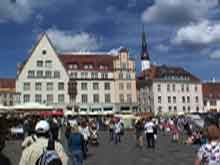 As you come back towards the main town area you are reminded that this is a major tourist center as well. It is very popular with visitors and can get quite crowded, especially when you get to the main entrance of the town.. Originally we entered through one of the back gates, which was a very nice first impression, with quiet, peaceful lanes. But we shall exit through the main front gate and main street, which can get quite crowded. It's a big funnel of people all passing through the same gate with lots of shops, busy pubs and restaurants all along the wide entrance street.
As you come back towards the main town area you are reminded that this is a major tourist center as well. It is very popular with visitors and can get quite crowded, especially when you get to the main entrance of the town.. Originally we entered through one of the back gates, which was a very nice first impression, with quiet, peaceful lanes. But we shall exit through the main front gate and main street, which can get quite crowded. It's a big funnel of people all passing through the same gate with lots of shops, busy pubs and restaurants all along the wide entrance street.
.jpg) We take a final look around as we bid our farewell – it's time to walk ten minutes back to the dock, reclaim our luggage, and board the overnight boat to Stockholm. When we have finished our Tallinn visit, we depart for Stockholm in the late afternoon by comfortable overnight ship. The large ship is a floating hotel, with comfortable cabins, restaurants, promenade decks, tax-free shopping malls and casinos. [back to top]
We take a final look around as we bid our farewell – it's time to walk ten minutes back to the dock, reclaim our luggage, and board the overnight boat to Stockholm. When we have finished our Tallinn visit, we depart for Stockholm in the late afternoon by comfortable overnight ship. The large ship is a floating hotel, with comfortable cabins, restaurants, promenade decks, tax-free shopping malls and casinos. [back to top]
STOCKHOLM
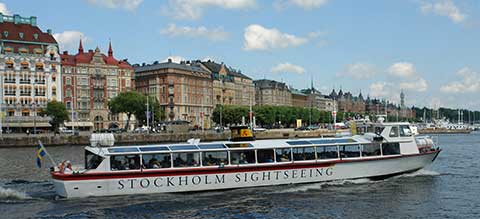
Stockholm is one of Europe’s truly beautiful capitals. This amazing city was created by a society that truly cares about people and provides for their welfare and their pleasure, resulting in wonderful conditions for the visitor to enjoy. Scandinavians believe in quality of life and are generally considered to have the world’s highest standard of living. Stockholm offers a magical blend of efficiency and beauty, romance and skill all working together to make your visit extremely rewarding. It is modern, yet has some of Europe’s best-preserved historic neighborhoods, with an atmospheric mix of ancient cobbled alleys, 17th century buildings and contemporary shops. Something special is happening here.
 You can easily keep busy and have fun in Stockholm for two days. The most worthwhile activities are: walk the Old Town (of course), take a boat ride around some of the city’s 14 islands, visit the reconstructed historic village of Skansen, tour the world’s largest occupied Royal Palace, visit the three best museums, check out the modern downtown and shop along the great pedestrian promenade of Drottninggatan. You’ll love it!
You can easily keep busy and have fun in Stockholm for two days. The most worthwhile activities are: walk the Old Town (of course), take a boat ride around some of the city’s 14 islands, visit the reconstructed historic village of Skansen, tour the world’s largest occupied Royal Palace, visit the three best museums, check out the modern downtown and shop along the great pedestrian promenade of Drottninggatan. You’ll love it!
-06.jpg) We will want to spend a lot of time exploring the quirky streets of Gamla Stan, the old town, where our hotel is located. This is the site of the medieval city center and is the number one most interesting place in town. Wandering the Gamla Stan is the prime reason for coming to Stockholm, so have a good look around. They just don’t build cities like this any more.
We will want to spend a lot of time exploring the quirky streets of Gamla Stan, the old town, where our hotel is located. This is the site of the medieval city center and is the number one most interesting place in town. Wandering the Gamla Stan is the prime reason for coming to Stockholm, so have a good look around. They just don’t build cities like this any more.
-04.jpg) The narrow twisting cobbled streets of Gamla Stan are lined with superbly preserved old buildings which contain some very modern stores, so you can enjoy the historic experience while shopping! In fact this neighborhood has been a place for commerce since the 12th century, when it was first settled as a trading center. Most of the handsome buildings you see now were built of brick and stone in the 17th century when Sweden was one of the greatest powers in Europe.
The narrow twisting cobbled streets of Gamla Stan are lined with superbly preserved old buildings which contain some very modern stores, so you can enjoy the historic experience while shopping! In fact this neighborhood has been a place for commerce since the 12th century, when it was first settled as a trading center. Most of the handsome buildings you see now were built of brick and stone in the 17th century when Sweden was one of the greatest powers in Europe.
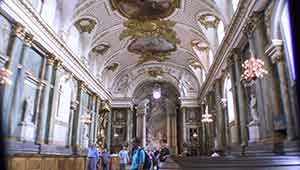 Nearby is the Drottningholm Palace, which is the largest occupied royal palace in the world. Arrive in the courtyard well before noon for a good position to see the spectacular Changing of the Guards. The highly decorated palace interior is typical of what you find throughout Europe’s extravagant royal mansions.
Nearby is the Drottningholm Palace, which is the largest occupied royal palace in the world. Arrive in the courtyard well before noon for a good position to see the spectacular Changing of the Guards. The highly decorated palace interior is typical of what you find throughout Europe’s extravagant royal mansions.
 The main event in Gamla Stan is to walk along the fascinating shopping lane, the Vasterlanggatan, but you will also enjoy a wander into the little side alleys, exploring past centuries frozen in stone. It is much quieter here away from the shopping throngs and there is an abundance of small pleasures to be found in the details of buildings, gardens and older shop fronts. There is so much rich atmosphere to absorb in Gamla Stan we will lead you back for another few hours on the final day.
The main event in Gamla Stan is to walk along the fascinating shopping lane, the Vasterlanggatan, but you will also enjoy a wander into the little side alleys, exploring past centuries frozen in stone. It is much quieter here away from the shopping throngs and there is an abundance of small pleasures to be found in the details of buildings, gardens and older shop fronts. There is so much rich atmosphere to absorb in Gamla Stan we will lead you back for another few hours on the final day.
 When hunger strikes you could find no better choice in Gamla Stan than the series of ancient restaurants behind the 13th-century Storkyrkan Cathedral on Skomakargatan. If the weather is mild you can sit outdoors, or better yet, have a traditional meal in their medieval barrel-vaulted cellars which were storerooms four hundred years ago. This you must see, even if you are merely passing by looking for a restroom. Here you really step down in time as you venture below street level. Alternatively, pick from the charming outdoor restaurants that line the Stortorget main square of the Gamla Stan, overlooking the historic Bourse stock market. This is the only part of town where stores remain open late, so you will have plenty of time for browsing and shopping until dropping.
When hunger strikes you could find no better choice in Gamla Stan than the series of ancient restaurants behind the 13th-century Storkyrkan Cathedral on Skomakargatan. If the weather is mild you can sit outdoors, or better yet, have a traditional meal in their medieval barrel-vaulted cellars which were storerooms four hundred years ago. This you must see, even if you are merely passing by looking for a restroom. Here you really step down in time as you venture below street level. Alternatively, pick from the charming outdoor restaurants that line the Stortorget main square of the Gamla Stan, overlooking the historic Bourse stock market. This is the only part of town where stores remain open late, so you will have plenty of time for browsing and shopping until dropping.
 We start our second day in Stockholm with two outstanding history museums that you would really enjoy — the Vasa and the Nordic. You will want to see the 17th century wooden warship, the Vasa, briefly the world’s largest battleship until it tragically sunk on its maiden voyage in 1628. It was top-heavy with hundreds of wooden statues. You can see them all, because the massive ship was rescued from the deep twenty years ago and put on display here, with many related nautical artifacts, and friendly knowledgeable guides who lead frequent tours of the exhibit. It looks brand new. When you are finished here walk one block over to the Nordic Museum, the largest collection of Scandinavian artifacts in the world. They have tons of history on display, including folk art, handicrafts, furniture, table-settings, clothing, interiors and special exhibits.
We start our second day in Stockholm with two outstanding history museums that you would really enjoy — the Vasa and the Nordic. You will want to see the 17th century wooden warship, the Vasa, briefly the world’s largest battleship until it tragically sunk on its maiden voyage in 1628. It was top-heavy with hundreds of wooden statues. You can see them all, because the massive ship was rescued from the deep twenty years ago and put on display here, with many related nautical artifacts, and friendly knowledgeable guides who lead frequent tours of the exhibit. It looks brand new. When you are finished here walk one block over to the Nordic Museum, the largest collection of Scandinavian artifacts in the world. They have tons of history on display, including folk art, handicrafts, furniture, table-settings, clothing, interiors and special exhibits.
SKANSEN
 After we finish these two museums take a five minute tram ride to Skansen, the world’s first, and still the best, outdoor museum. Sweden-in-a-nutshell, this vast park features about 150 houses and farmsteads that have been collected from all over the country and brought together in an exquisite living exhibit. For many of you this transplanted chunk of old-fashioned life will be the main highlight of Stockholm. Most of the houses are open only from 11:00am until 5:00pm, so we don’t want to get here when the park gates open at 10:00am. Arrive at mid-day and recharge your batteries with lunch at one of the many eateries in the park or just outside the gates.
After we finish these two museums take a five minute tram ride to Skansen, the world’s first, and still the best, outdoor museum. Sweden-in-a-nutshell, this vast park features about 150 houses and farmsteads that have been collected from all over the country and brought together in an exquisite living exhibit. For many of you this transplanted chunk of old-fashioned life will be the main highlight of Stockholm. Most of the houses are open only from 11:00am until 5:00pm, so we don’t want to get here when the park gates open at 10:00am. Arrive at mid-day and recharge your batteries with lunch at one of the many eateries in the park or just outside the gates.
-06.jpg) Skansen’s buildings date from the 18th, 19th and 20th centuries, and show how people in different social classes lived, worked and were housed. There are costumed local guides dressed in historic outfits ready to explain the story of each display and tell you about life as it used to be lived in the house you are visiting. You will also find animals in the farmyard, and a naturalistic zoo with bears, bison, elk, wolves and reindeer. Later you can enjoy a charming folk dance performance with live music and skilled traditional dancers.
Skansen’s buildings date from the 18th, 19th and 20th centuries, and show how people in different social classes lived, worked and were housed. There are costumed local guides dressed in historic outfits ready to explain the story of each display and tell you about life as it used to be lived in the house you are visiting. You will also find animals in the farmyard, and a naturalistic zoo with bears, bison, elk, wolves and reindeer. Later you can enjoy a charming folk dance performance with live music and skilled traditional dancers.
You will want to see some of the modern downtown and visit the fine art museum, eat in a stylish café, walk the main shopping street back to the Gamla Stan in the afternoon and stay there through the evening.
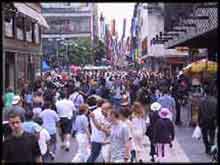 The center of downtown has some interesting streets and squares around it, so have a brief look as you walk past heading for the nicest shopping blocks of Hamngatan where you began your tour at the information office. If you want to peek inside NK go ahead, but it’s just another big department store. For more posh shops walk another two blocks to Birger Jarlsgatan and take a left up to Ostermalmstorg if you would like to grab some take-out, or just look at the Sluhallen food market. Then we walk to the very pretty park called Kungstragarden which is the outdoor living room of the city. Here you will find locals relaxing, kids playing, fountains gushing, statues standing and flowers blooming.
The center of downtown has some interesting streets and squares around it, so have a brief look as you walk past heading for the nicest shopping blocks of Hamngatan where you began your tour at the information office. If you want to peek inside NK go ahead, but it’s just another big department store. For more posh shops walk another two blocks to Birger Jarlsgatan and take a left up to Ostermalmstorg if you would like to grab some take-out, or just look at the Sluhallen food market. Then we walk to the very pretty park called Kungstragarden which is the outdoor living room of the city. Here you will find locals relaxing, kids playing, fountains gushing, statues standing and flowers blooming.
-06.jpg) Passing through the gardens we pop out the other end by the waterfront near the National Museum, which holds the country’s main collection of fine arts, including a sprinkling of Old Masters and Impressionists. It is a good museum, definitely worthwhile for the art lover. After the museum, enjoy some refreshments in the opulent Grand Hotel, or perhaps enjoy their fabulous smorgasbord buffet featuring a dozen kinds of fresh herring. Another nearby restaurant is the very famous Operakallaren in the Opera House. It’s now an art deco masterpiece, first opened in the 18th century and noted for a smorgasbord lunch and heavy crowds, so it’s better to arrive at a non-peak time. Upstairs you will find the equally beautiful Opera Café, also busy at lunch and dinner.
Passing through the gardens we pop out the other end by the waterfront near the National Museum, which holds the country’s main collection of fine arts, including a sprinkling of Old Masters and Impressionists. It is a good museum, definitely worthwhile for the art lover. After the museum, enjoy some refreshments in the opulent Grand Hotel, or perhaps enjoy their fabulous smorgasbord buffet featuring a dozen kinds of fresh herring. Another nearby restaurant is the very famous Operakallaren in the Opera House. It’s now an art deco masterpiece, first opened in the 18th century and noted for a smorgasbord lunch and heavy crowds, so it’s better to arrive at a non-peak time. Upstairs you will find the equally beautiful Opera Café, also busy at lunch and dinner.
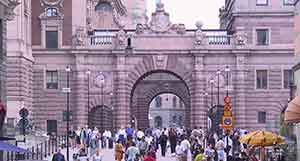 The busy pedestrian shopping street of Drottninggatan is a major attraction, and runs all the way through town, filled mostly with locals out for a stroll - a perfect spot for people-watching. Here you will find several side streets that are also worth exploring in this shopping center of town. Make your way south along this lane heading back towards the Gamla Stan. You will pass over a canal and through two triumphal arches at the back of the Parliament, where you can take a brief detour if you want another glimpse back into the past. The Museum of Medieval Times, underneath the Parliament, recreates the atmosphere of old Stockholm including a section of the city wall and many artifacts from the Viking days.
The busy pedestrian shopping street of Drottninggatan is a major attraction, and runs all the way through town, filled mostly with locals out for a stroll - a perfect spot for people-watching. Here you will find several side streets that are also worth exploring in this shopping center of town. Make your way south along this lane heading back towards the Gamla Stan. You will pass over a canal and through two triumphal arches at the back of the Parliament, where you can take a brief detour if you want another glimpse back into the past. The Museum of Medieval Times, underneath the Parliament, recreates the atmosphere of old Stockholm including a section of the city wall and many artifacts from the Viking days.
 As you walk back along the shopping route you will discover this same narrow pedestrian alley continues as the main commercial spine of the Old Town that you were on your first day. It totals nearly a mile of shopping nirvana. It is great to be back in this enchanted neighborhood, the best part of Stockholm. Street musicians will entertain as you stroll along. Things to buy include the famous Swedish crystal and related glassware, wooden toys, silverware, handicrafts and anything that shows Swedish design. Non-shoppers can wander into little side alleys to explore four centuries of ancient buildings. The more you stroll around Stockholm, the more you’ll appreciate how much variety of architecture there is to enjoy.
As you walk back along the shopping route you will discover this same narrow pedestrian alley continues as the main commercial spine of the Old Town that you were on your first day. It totals nearly a mile of shopping nirvana. It is great to be back in this enchanted neighborhood, the best part of Stockholm. Street musicians will entertain as you stroll along. Things to buy include the famous Swedish crystal and related glassware, wooden toys, silverware, handicrafts and anything that shows Swedish design. Non-shoppers can wander into little side alleys to explore four centuries of ancient buildings. The more you stroll around Stockholm, the more you’ll appreciate how much variety of architecture there is to enjoy.
 If you can find any spare hours between our suggestions, hop another boat for the “Under the Bridges” two-hour tour if you enjoyed the water first time around. It’s especially nice towards sunset. Venturing further afield, there are many palaces and homes devoted to Sweden’s monarchs scattered throughout suburbia, connected with a multitude of parks, walking paths and bicycle trails. You can walk everywhere in this civilized place, or utilize the efficient public transit bus and subway system to really cover some extra ground. The Swedes are friendly and most of them speak English, so it is worth your effort to say hello. [back to top]
If you can find any spare hours between our suggestions, hop another boat for the “Under the Bridges” two-hour tour if you enjoyed the water first time around. It’s especially nice towards sunset. Venturing further afield, there are many palaces and homes devoted to Sweden’s monarchs scattered throughout suburbia, connected with a multitude of parks, walking paths and bicycle trails. You can walk everywhere in this civilized place, or utilize the efficient public transit bus and subway system to really cover some extra ground. The Swedes are friendly and most of them speak English, so it is worth your effort to say hello. [back to top]
OSLO
 July 19 This morning we travel by train from Stockholm to Oslo through very scenic countryside covered with farms and forests. You will be delighted with our visit to Oslo, capital of Norway, which the United Nations has ranked as the best country in the world to live. The fascinating downtown is a compact area just one mile long and a half-mile wide, filled with the typical European variety of shops, parks, restaurants, museums, scenic waterfront and historic sights to keep you highly entertained for several days. Oslo’s population is only 550,000, making it the smallest Scandinavian capital, and very easy to get around.
July 19 This morning we travel by train from Stockholm to Oslo through very scenic countryside covered with farms and forests. You will be delighted with our visit to Oslo, capital of Norway, which the United Nations has ranked as the best country in the world to live. The fascinating downtown is a compact area just one mile long and a half-mile wide, filled with the typical European variety of shops, parks, restaurants, museums, scenic waterfront and historic sights to keep you highly entertained for several days. Oslo’s population is only 550,000, making it the smallest Scandinavian capital, and very easy to get around.
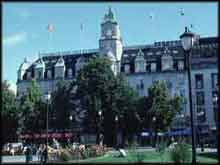 Our hotel has a prime location in the central section of the main street, Karl Johans Gate, which begins at the train station and continues for one mile to the Royal Palace. This boulevard is definitely the heart of town, buzzing with people all day long. Karl Johans has fine shops and restaurants along both sides in the neighborhood of the train station where it is a lively pedestrian mall extending for six blocks, with several enticing side streets also reserved for pedestrians.
Our hotel has a prime location in the central section of the main street, Karl Johans Gate, which begins at the train station and continues for one mile to the Royal Palace. This boulevard is definitely the heart of town, buzzing with people all day long. Karl Johans has fine shops and restaurants along both sides in the neighborhood of the train station where it is a lively pedestrian mall extending for six blocks, with several enticing side streets also reserved for pedestrians.
-06.jpg) Today's orientation walk begins across the street in a pretty park that is Oslo’s major gathering place in fair weather, serving as an outdoor living room. The busy garden café in the middle is an excellent place to stop later for drinks and a light meal, or just sit on a bench and watch the entertainers. At one end stands the Parliament, finished in 1866 with a mix of Renaissance and Neoclassical styles that has created one of the prettiest building in town.
Today's orientation walk begins across the street in a pretty park that is Oslo’s major gathering place in fair weather, serving as an outdoor living room. The busy garden café in the middle is an excellent place to stop later for drinks and a light meal, or just sit on a bench and watch the entertainers. At one end stands the Parliament, finished in 1866 with a mix of Renaissance and Neoclassical styles that has created one of the prettiest building in town.
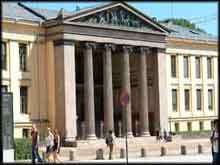 Oslo’s three main shopping streets, Karl Johans, Rosenkrantz and Stortingsgata, surround this popular park, forming Oslo’s best neighborhood. At the next block along Karl Johans we find the oldest university buildings in Oslo, opened in 1854. The three attractive university buildings are in the Neoclassical style with impressive columns and pediments, set back in a one-block campus of green lawns and tall trees. Have a look inside the central building to appreciate the beautiful entrance hall, lined with tall columns and coffered ceiling, like a Greek temple, and then proceed into the auditorium where you will find three walls covered with large murals by Edvard Munch, Norway’s most famous artist, who worked on them for ten years. Many more paintings by Munch await those interested in the next few days.
Oslo’s three main shopping streets, Karl Johans, Rosenkrantz and Stortingsgata, surround this popular park, forming Oslo’s best neighborhood. At the next block along Karl Johans we find the oldest university buildings in Oslo, opened in 1854. The three attractive university buildings are in the Neoclassical style with impressive columns and pediments, set back in a one-block campus of green lawns and tall trees. Have a look inside the central building to appreciate the beautiful entrance hall, lined with tall columns and coffered ceiling, like a Greek temple, and then proceed into the auditorium where you will find three walls covered with large murals by Edvard Munch, Norway’s most famous artist, who worked on them for ten years. Many more paintings by Munch await those interested in the next few days.
From here it is an easy three-block walk towards the waterfront to see the impressive home of the city government. City Hall was a built between 1931 and 1950 in what was then the very modern style of Functionalism, with a plain brick design that looks like three large, plain boxes.
-06.jpg) City Hall faces the harbor, which is a major focus of activities in Oslo, with a large restaurant mall, historic sights and excursion boat services. Here you will find Aker Brygge, the most exciting dining and shopping complex in town, where a shipyard that stood until the 1970s has now been transformed into a wonderful place to have a meal, do a little shopping and take a stroll along the waterfront. An indoor food court and lovely sidewalk cafes offer prime position for watching the attractive crowds on parade along the waterfront.
City Hall faces the harbor, which is a major focus of activities in Oslo, with a large restaurant mall, historic sights and excursion boat services. Here you will find Aker Brygge, the most exciting dining and shopping complex in town, where a shipyard that stood until the 1970s has now been transformed into a wonderful place to have a meal, do a little shopping and take a stroll along the waterfront. An indoor food court and lovely sidewalk cafes offer prime position for watching the attractive crowds on parade along the waterfront.
-06.jpg) Returning back into the center of downtown, we pass through the pretty square in front of the Oslo Cathedral, the Domkirche (1697). The Stortorvet Square in front often hosts a colorful flower market, and across the street is Oslo's largest and best department store, Glas Magasinet, which offers many goods of Norwegian design, and is especially noted for high-quality glass works. Stables that once circled this square have been converted into attractive shops and cafes. Yet another pedestrian mall, Torggata, extends three blocks north from here into another nice shopping area that could keep you busy for the rest of the evening.
Returning back into the center of downtown, we pass through the pretty square in front of the Oslo Cathedral, the Domkirche (1697). The Stortorvet Square in front often hosts a colorful flower market, and across the street is Oslo's largest and best department store, Glas Magasinet, which offers many goods of Norwegian design, and is especially noted for high-quality glass works. Stables that once circled this square have been converted into attractive shops and cafes. Yet another pedestrian mall, Torggata, extends three blocks north from here into another nice shopping area that could keep you busy for the rest of the evening.
This morning we enjoy a tour that takes us to a couple of important sights on the edge of town beyond walking distance — including Frogner Park, with an amazing outdoor sculpture collection. During the ride you will hear about Oslo's history as well as get shopping and dining tips which can greatly enhance your visit. Riding along we discover that Oslo is a green city with lots of trees, fountains, parks and gardens. There are many neighborhoods of beautiful, old houses mixed nicely together with modern apartments.
 The Vigeland Sculpture Park is often cited as Oslo's top attraction, so it should not be missed: an amazing collection of 200 statues by Gustav Vigeland, arranged in one of the world's most interesting sculpture gardens. Even those who don't care much for statues, this will find this a worthwhile expedition because the subjects are people and human emotions, which have universal appeal. The pastoral setting in a large, green park also enhances the experience.
The Vigeland Sculpture Park is often cited as Oslo's top attraction, so it should not be missed: an amazing collection of 200 statues by Gustav Vigeland, arranged in one of the world's most interesting sculpture gardens. Even those who don't care much for statues, this will find this a worthwhile expedition because the subjects are people and human emotions, which have universal appeal. The pastoral setting in a large, green park also enhances the experience.
-06.jpg) We then continue by bus to the Bygod Peninsula, where there are several outstanding museums. Imagine traveling back to the 19th century and seeing all of Norway in one small park, with original farm houses, country manors, village centers and local experts dressed in authentic costumes to tell you all about it. That is just what you will find at the amazing Norwegian Folk Museum, one of Europe's largest open air museums, with 150 original buildings moved here from all regions of Norway.
We then continue by bus to the Bygod Peninsula, where there are several outstanding museums. Imagine traveling back to the 19th century and seeing all of Norway in one small park, with original farm houses, country manors, village centers and local experts dressed in authentic costumes to tell you all about it. That is just what you will find at the amazing Norwegian Folk Museum, one of Europe's largest open air museums, with 150 original buildings moved here from all regions of Norway.
-06.jpg) Each building cluster has a knowledgeable guide in native costume who will entertain you with a personal tour of the property, demonstrate some crafts and answer any questions you might have. You might see a blacksmith in action, taste some freshly baked goods, or watch the goats and pigs being fed. The most important treasure is the traditional Stave Church, with its tall, gabled roof dating to the Middle Ages. Interior visits of each site show you traditional furniture, kitchen utensils and domestic items which really provide an accurate feeling for the traditional culture. As you walk through the homes and farms with your guides, they often tell stories about the actual people who lived there, bringing the nation's history to life.
Each building cluster has a knowledgeable guide in native costume who will entertain you with a personal tour of the property, demonstrate some crafts and answer any questions you might have. You might see a blacksmith in action, taste some freshly baked goods, or watch the goats and pigs being fed. The most important treasure is the traditional Stave Church, with its tall, gabled roof dating to the Middle Ages. Interior visits of each site show you traditional furniture, kitchen utensils and domestic items which really provide an accurate feeling for the traditional culture. As you walk through the homes and farms with your guides, they often tell stories about the actual people who lived there, bringing the nation's history to life.
 The grounds are landscaped in a natural way that gives the feeling of being way out in the country, with farm animals to create that rural atmosphere. Each building complex is separated from the others by trees and pastures, so you can enjoy the adventure of navigating from one area to the next as you discover the many sites. Nearly all the park's buildings are made of wood, since timber was the main natural resource of Norway. This gives an earthy appearance to the design that is greatly enhanced by the sod roofs on many of the houses.
Lovers of arts and crafts will be especially delighted with the Old Town center where the artisans have their workshops, demonstrating traditional skills and selling unique products made there. This includes a silversmith, weavers, candle makers and especially, The Pottery, which has been part of the park for 50 years. Some kind of musical entertainment is usually going on to further enhance your visit to the park.
The grounds are landscaped in a natural way that gives the feeling of being way out in the country, with farm animals to create that rural atmosphere. Each building complex is separated from the others by trees and pastures, so you can enjoy the adventure of navigating from one area to the next as you discover the many sites. Nearly all the park's buildings are made of wood, since timber was the main natural resource of Norway. This gives an earthy appearance to the design that is greatly enhanced by the sod roofs on many of the houses.
Lovers of arts and crafts will be especially delighted with the Old Town center where the artisans have their workshops, demonstrating traditional skills and selling unique products made there. This includes a silversmith, weavers, candle makers and especially, The Pottery, which has been part of the park for 50 years. Some kind of musical entertainment is usually going on to further enhance your visit to the park.
-06.jpg) After the folk park, walk about ten minutes to the Viking Ship Museum, 600 yards away, or wait for the city bus to bring you there. This small museum is another one of the treasures of Oslo, containing two large Viking ships and many cases of artifacts accompanied by informative descriptions. We then walk back to the ferry dock at Dronningen for the ten-minute boat trip back to City Hall.
After the folk park, walk about ten minutes to the Viking Ship Museum, 600 yards away, or wait for the city bus to bring you there. This small museum is another one of the treasures of Oslo, containing two large Viking ships and many cases of artifacts accompanied by informative descriptions. We then walk back to the ferry dock at Dronningen for the ten-minute boat trip back to City Hall.
Today you will enjoy further explorations in Oslo and we have several suggestions. This would be an excellent time to visit Oslo's two major museums for art and history, easy to find in the center of town just behind the three university buildings, one block from Karl Johans Gate on Kristian IV's Gate. These fascinating museums are free and worth at least one hour each.
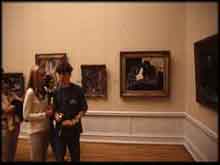 The National Gallery is the most important art museum in the country, with an excellent collection of important European paintings in a large space extending through 60 rooms on 3 floors. You'll be delighted by the nice sample of French artists, including Manet, Renoir, Cézanne, Gaughin and Matisse along with several rooms of Old Masters from Renaissance and Baroque times, including Velasquez and El Greco.
The National Gallery is the most important art museum in the country, with an excellent collection of important European paintings in a large space extending through 60 rooms on 3 floors. You'll be delighted by the nice sample of French artists, including Manet, Renoir, Cézanne, Gaughin and Matisse along with several rooms of Old Masters from Renaissance and Baroque times, including Velasquez and El Greco.
-06.jpg) The Historical Museum, one block away, covers the evolution of culture from the Stone Age through the Middle Ages, then continues the human story with an Ethnographic Collection, exhibiting artifacts from the Arctic, Africa and the Americas. The Viking section is especially interesting: horned helmets, battleaxes, farming implements, swords, boats, gold jewelry and hundreds of other fascinating items depicting life of those infamous Norwegians, who thrived in the years 780 through 1050.
The Historical Museum, one block away, covers the evolution of culture from the Stone Age through the Middle Ages, then continues the human story with an Ethnographic Collection, exhibiting artifacts from the Arctic, Africa and the Americas. The Viking section is especially interesting: horned helmets, battleaxes, farming implements, swords, boats, gold jewelry and hundreds of other fascinating items depicting life of those infamous Norwegians, who thrived in the years 780 through 1050.
-06.jpg) We can then walk back to the harbor and visit the imposing Akershus Castle and Fortress, which is Oslo's oldest and most historic attraction, built between 1299 and 1319. A ten-minute walk along the waterfront around the fortress grounds brings you up the fort's ramparts, which offer a lovely view looking back across the harbor.
We can then walk back to the harbor and visit the imposing Akershus Castle and Fortress, which is Oslo's oldest and most historic attraction, built between 1299 and 1319. A ten-minute walk along the waterfront around the fortress grounds brings you up the fort's ramparts, which offer a lovely view looking back across the harbor.
Next we stroll through the oldest section of town between the fortress and the Parliament. This neighborhood offers pleasant shops, restaurants, a couple of modern art museums and a mix of old and new buildings, presenting an outstanding shopping and tbusiness environment that has special appeal for connoisseurs of city life.
 A slight detour of a few blocks will bring us over to Oslo's spectacular new opera house on the waters edge, where we can walk on the roof of this curvaceous ultra-modern creation. From here we can easily reach downtown's largest indoor shopping mall.
A slight detour of a few blocks will bring us over to Oslo's spectacular new opera house on the waters edge, where we can walk on the roof of this curvaceous ultra-modern creation. From here we can easily reach downtown's largest indoor shopping mall.
Art-lovers would thoroughly enjoy a visit to the Munch Museum, which has about 1,000 of his paintings displayed in thisv modern building which opened in 1963. It is beyond walking distance, but easily reached by metro to Toyen and then a short walk to the museum, which also has a nice snack bar and gift shop.
 It's ironic that Edvard Munch (1863-1944) is widely known for just one painting, "The Scream," and yet the rest of his pictures show the same skillful hand at work, laced with existential anxiety and strong human feelings. These other pieces are not well know because he sold very few paintings and donated his entire collection for this museumv. You have to come to Oslo to experience the wide range of subjects and emotions he explored. Munch studied in Berlin and Paris, influenced by Gauguin, Van Gogh and other Post-Impressionists, but then took the art world to a new level of Expressionism, infused with powerful, frightening passions and brilliant colors. By now the day is nearly done and you are free to take it from there and find a nice dinner. [back to top]
It's ironic that Edvard Munch (1863-1944) is widely known for just one painting, "The Scream," and yet the rest of his pictures show the same skillful hand at work, laced with existential anxiety and strong human feelings. These other pieces are not well know because he sold very few paintings and donated his entire collection for this museumv. You have to come to Oslo to experience the wide range of subjects and emotions he explored. Munch studied in Berlin and Paris, influenced by Gauguin, Van Gogh and other Post-Impressionists, but then took the art world to a new level of Expressionism, infused with powerful, frightening passions and brilliant colors. By now the day is nearly done and you are free to take it from there and find a nice dinner. [back to top]
BERGEN
 For our final destination of the tour we are heading to the far western shores of Norway to visit the charming seaside town of Bergen. To get there we're going to take you on one of the most spectacular train rides in all of Europe: starting in Oslo, we're heading cross-country through some fascinating mountain terrain, passing lakes and rivers and waterfalls, and then by boat through a vast fjord, finally we will be arriving later in the day at the ancient capital of Norway the town of Bergen.
For our final destination of the tour we are heading to the far western shores of Norway to visit the charming seaside town of Bergen. To get there we're going to take you on one of the most spectacular train rides in all of Europe: starting in Oslo, we're heading cross-country through some fascinating mountain terrain, passing lakes and rivers and waterfalls, and then by boat through a vast fjord, finally we will be arriving later in the day at the ancient capital of Norway the town of Bergen.
.jpg) It's always a pleasure to travel by train. Among the many advantages: You have wonderful scenery out the windows; don't have to worry about driving on getting stuck in traffic; not crammed in like on a bus; you can walk around in the train, kick back and read a book or take a nap; visit the snack car and have some coffee or a complete meal, like a coffee shop on wheels. The train is a lovely setting for conversation and meeting some Scandinavians. Nobody's in a rush at this point, so it's an interesting place to meet local people.
It's always a pleasure to travel by train. Among the many advantages: You have wonderful scenery out the windows; don't have to worry about driving on getting stuck in traffic; not crammed in like on a bus; you can walk around in the train, kick back and read a book or take a nap; visit the snack car and have some coffee or a complete meal, like a coffee shop on wheels. The train is a lovely setting for conversation and meeting some Scandinavians. Nobody's in a rush at this point, so it's an interesting place to meet local people.
.jpg) The scenery keeps getting more spectacular as we climb through the central regions of Norway, looking much like Switzerland with tall mountains in the distance and glaciers, with lakes where the water is clear blue color. The visual feast is like a natural painting with trees and bushes along the edge of the water, lovely grasses and shrubs and wonderful colorful elements of nature beyond our windows. The alpine rail journey along Norway’s high plateau presents several hours of Alpine wonders, with fine views of glaciers, lakes, tundra and evergreen forests along the entire route, enjoyed in the comforts of our modern train.
The scenery keeps getting more spectacular as we climb through the central regions of Norway, looking much like Switzerland with tall mountains in the distance and glaciers, with lakes where the water is clear blue color. The visual feast is like a natural painting with trees and bushes along the edge of the water, lovely grasses and shrubs and wonderful colorful elements of nature beyond our windows. The alpine rail journey along Norway’s high plateau presents several hours of Alpine wonders, with fine views of glaciers, lakes, tundra and evergreen forests along the entire route, enjoyed in the comforts of our modern train.
.jpg) We change trains mid-way and board the Flam railway which takes us about a mile from the mountain tops down through seven lush valleys to the waters below in the Sognefjord, Norway's largest fjord. The Flam Railway is one of the most scenic rides in Europe and fortunately stops now and then to let passengers get off the train to enjoy the view. The most spectacular sight is a rolling gushing waterfall -- a terrific photo opportunity but wipe the water off of your lens -- it is like being on the maid of the mist at Niagara Falls with a big spray coming at you. We soon reach the water's edge and transfer to the boat that will bring us the rest of the way to Bergen through the dramatic fjord.
We change trains mid-way and board the Flam railway which takes us about a mile from the mountain tops down through seven lush valleys to the waters below in the Sognefjord, Norway's largest fjord. The Flam Railway is one of the most scenic rides in Europe and fortunately stops now and then to let passengers get off the train to enjoy the view. The most spectacular sight is a rolling gushing waterfall -- a terrific photo opportunity but wipe the water off of your lens -- it is like being on the maid of the mist at Niagara Falls with a big spray coming at you. We soon reach the water's edge and transfer to the boat that will bring us the rest of the way to Bergen through the dramatic fjord.
.jpg) We continue a few hours by boat through the Sognefjord, the longest and most dramatic fjord in Norway, framed by steep sea cliffs rising thousands of feet. This area is one of the world’s most beautiful travel destinations and is included as a UNESCO World Heritage Site. This will be a day of dramatic scenery all around during the boat ride, with the mountains towering high above on both sides of this chasm.
We continue a few hours by boat through the Sognefjord, the longest and most dramatic fjord in Norway, framed by steep sea cliffs rising thousands of feet. This area is one of the world’s most beautiful travel destinations and is included as a UNESCO World Heritage Site. This will be a day of dramatic scenery all around during the boat ride, with the mountains towering high above on both sides of this chasm.
After a few hours we get our first breathtaking glimpse of the town of Bergen, located in the head of a long natural inlet, enhanced a picturesque harbor lined with historic buildings. Bergen is nestled at the foot seven mountains which surround the scenic harbor.
.jpg) We arrive late in the afternoon, check in to our hotel, then enjoy a brief orientation walk, with free time later in the evening. During the summer there is a very late and long twilight, with sunset stretching on for an hour and finally getting dark about 11 pm, making the evening a great time for being out and about, having a look at the people and diverse neighborhoods of this city. After the long day we retire to our hotel, conveniently located on the central pedestrian mall of the city a few blocks from the waterfront. Bergen is the second biggest city in Norway with a population of about 250,00 people, and in typical European style, the downtown is quite lively and filled with shops, cafes, restaurants and pedestrian streets.
We arrive late in the afternoon, check in to our hotel, then enjoy a brief orientation walk, with free time later in the evening. During the summer there is a very late and long twilight, with sunset stretching on for an hour and finally getting dark about 11 pm, making the evening a great time for being out and about, having a look at the people and diverse neighborhoods of this city. After the long day we retire to our hotel, conveniently located on the central pedestrian mall of the city a few blocks from the waterfront. Bergen is the second biggest city in Norway with a population of about 250,00 people, and in typical European style, the downtown is quite lively and filled with shops, cafes, restaurants and pedestrian streets.
July 23: We're up the next morning for buffet breakfast and a big final day: walking tour of town and the outdoor food market on the harbor; visit to the Brygen; and ride up the mountain by funicular to get a great view over the city. Our walking tour will have a look at downtown and some of the quiet residential neighborhoods.
.jpg) A short walk to the edge of town brings you to the funicular which takes you up the Floyen Mountain for a marvelous view across the city from a 1000-foot high observation perch. The ride just takes eight minutes, making this an easy excursion. At the top you get a spectacular view of the town of Bergen and the harbor, making a nice way to start the day. You can spot various attractions from up here and visually plot out where you want to walk to later in the day, showing some idea of how far things are from each other. You'll see: the University Museum; Brygen Museum; a park in the midst of downtown; the harbor and adjacent food marketplace; the network of downtown streets, and much more. At the top there is a series of nature trails if you really want to get into it. When you are finished you might consider walking down the attractive path through the woods for a nature hike that provides beautiful scenery along with some exercise.
A short walk to the edge of town brings you to the funicular which takes you up the Floyen Mountain for a marvelous view across the city from a 1000-foot high observation perch. The ride just takes eight minutes, making this an easy excursion. At the top you get a spectacular view of the town of Bergen and the harbor, making a nice way to start the day. You can spot various attractions from up here and visually plot out where you want to walk to later in the day, showing some idea of how far things are from each other. You'll see: the University Museum; Brygen Museum; a park in the midst of downtown; the harbor and adjacent food marketplace; the network of downtown streets, and much more. At the top there is a series of nature trails if you really want to get into it. When you are finished you might consider walking down the attractive path through the woods for a nature hike that provides beautiful scenery along with some exercise.
.jpg) There are many fine sites to see in town that will keep you quite busy and entertained. One of the fun activities is a visit to the colorful open-air food market at the harbor, especially busy in the summertime, rich with fresh produce, fish and meat. They have fruits and sandwiches to go as well so you can pick up a relatively inexpensive lunch, or just get a light bite while browsing around.
There are many fine sites to see in town that will keep you quite busy and entertained. One of the fun activities is a visit to the colorful open-air food market at the harbor, especially busy in the summertime, rich with fresh produce, fish and meat. They have fruits and sandwiches to go as well so you can pick up a relatively inexpensive lunch, or just get a light bite while browsing around.
.jpg) The most impressive historic site in Bergen is the large collection of wooden buildings known as the Brygen, constructed about 300 years ago. These wooden buildings are so important they are on the UNESCO list of world heritage sites. The Brygen was the main residences, offices, shops and warehouses of this thriving town, which was one of the important cities of the Hanseatic League, the major trading network of Northern Europe. The buildings are open as a living museum, with guides in period costumes who walk you through it and explain the fascinating history. The tour brings you into three separate museums in this building complex, filled with original artifacts and structures that reveal the daily life of these early merchants, sailors and fishermen.
The most impressive historic site in Bergen is the large collection of wooden buildings known as the Brygen, constructed about 300 years ago. These wooden buildings are so important they are on the UNESCO list of world heritage sites. The Brygen was the main residences, offices, shops and warehouses of this thriving town, which was one of the important cities of the Hanseatic League, the major trading network of Northern Europe. The buildings are open as a living museum, with guides in period costumes who walk you through it and explain the fascinating history. The tour brings you into three separate museums in this building complex, filled with original artifacts and structures that reveal the daily life of these early merchants, sailors and fishermen.
.jpg) As you will discover, the Brygen is more than just a façade of shop fronts -- it's an entire historic neighborhood connected by wooden alleyways with restaurants, more shops. The museum was created on the spot about 20 years ago after a fire burned out several structures. Archaeologists came in after the fire and did some important excavations that discovered the earliest foundations of house sites which gave clues into the daily life of the people who lived here hundreds of years ago. After touring the historic displays leave time for exploring the shops sprinkled throughout this complex, many with specialty items of Norway.
As you will discover, the Brygen is more than just a façade of shop fronts -- it's an entire historic neighborhood connected by wooden alleyways with restaurants, more shops. The museum was created on the spot about 20 years ago after a fire burned out several structures. Archaeologists came in after the fire and did some important excavations that discovered the earliest foundations of house sites which gave clues into the daily life of the people who lived here hundreds of years ago. After touring the historic displays leave time for exploring the shops sprinkled throughout this complex, many with specialty items of Norway.
.jpg) In the hillside behind the Brygen you can wander through a residential neighborhood that developed hundreds of years ago before there were any automobiles, so as as a result you have narrow, quiet lanes that are for pedestrians, making a peaceful place to stroll. Bergen is worth exploring just to browse around the old streets and alleyways, which can be a most satisfying experience. The small wooden houses lying higgledy-piggledy, cobblestone step ways climb steeply and the passion for flowers is all around. You'll find he occasional shop in the middle of this residential district as well.
In the hillside behind the Brygen you can wander through a residential neighborhood that developed hundreds of years ago before there were any automobiles, so as as a result you have narrow, quiet lanes that are for pedestrians, making a peaceful place to stroll. Bergen is worth exploring just to browse around the old streets and alleyways, which can be a most satisfying experience. The small wooden houses lying higgledy-piggledy, cobblestone step ways climb steeply and the passion for flowers is all around. You'll find he occasional shop in the middle of this residential district as well.
.jpg) It's a charming spot that has been beautifully preserved. There are little gardens in front of immaculate houses, with little alley ways you can walk through -- very charming and picturesque. This neighborhood is very close to the shopping area, only about five blocks away from the busy downtown streets that have buses and cars and stores and outdoor markets, but here in this residential quarter there is an entirely different atmosphere of a quiet, peaceful, calm. You can come up here in the morning or afternoon to have a stroll, and you'll see very few cars in these narrow lanes. It's a queit neighborhood for local residents.
It's a charming spot that has been beautifully preserved. There are little gardens in front of immaculate houses, with little alley ways you can walk through -- very charming and picturesque. This neighborhood is very close to the shopping area, only about five blocks away from the busy downtown streets that have buses and cars and stores and outdoor markets, but here in this residential quarter there is an entirely different atmosphere of a quiet, peaceful, calm. You can come up here in the morning or afternoon to have a stroll, and you'll see very few cars in these narrow lanes. It's a queit neighborhood for local residents.
.jpg) An outstanding visit is to nearby Bergenhus fortress, the castle at the mouth of the harbor with some buildings dating back to the 1240s, when it was first constructed as the main fortified home of Norway's rulers. If you explore it you'll see their grand meeting hall and other rooms with historic displays of furnishings, costumes and weapons. You will learn that 600 years ago Bergen was densely populated, the largest city in Norway and capital of the country. Two of the main buildings in the fort are Rosenkrantz Tower and Haakon's Hall, the royal chamber built around 1260, which is the largest non-religious medieval building still standing in Norway. The castle basement is vaulted in a medieval style to prevent fire and to hold up the floor of the banquet hall above it. This complex is still used today for ceremonial events and concerts.
An outstanding visit is to nearby Bergenhus fortress, the castle at the mouth of the harbor with some buildings dating back to the 1240s, when it was first constructed as the main fortified home of Norway's rulers. If you explore it you'll see their grand meeting hall and other rooms with historic displays of furnishings, costumes and weapons. You will learn that 600 years ago Bergen was densely populated, the largest city in Norway and capital of the country. Two of the main buildings in the fort are Rosenkrantz Tower and Haakon's Hall, the royal chamber built around 1260, which is the largest non-religious medieval building still standing in Norway. The castle basement is vaulted in a medieval style to prevent fire and to hold up the floor of the banquet hall above it. This complex is still used today for ceremonial events and concerts.
.jpg) Just a few blocks away is the oldest building in Bergen, St. Mary's Church, which dates back to the 12th century. It's a rare example of the Romanesque architecture and therefore, it's really one of the most important and historic buildings in the entire country. It's been rebuilt over the years and renovated and redecorated, but you can still see the basic Romanesque structure with the walls around it vaulted arches and a very small windows. It's been in continuous use ever since.
Just a few blocks away is the oldest building in Bergen, St. Mary's Church, which dates back to the 12th century. It's a rare example of the Romanesque architecture and therefore, it's really one of the most important and historic buildings in the entire country. It's been rebuilt over the years and renovated and redecorated, but you can still see the basic Romanesque structure with the walls around it vaulted arches and a very small windows. It's been in continuous use ever since.
.jpg) The University campus has an interesting culture history Museum and the admission is free, so you can go on inside and have a look around to see items that date back as far as the stone age, all of which give you real feeling for life in the early days. You can see suits of armor, wooden tools, traditional costumes, furniture, farming implements and other cultural materials that have particular reference to Western Norway. This is a fine collection ranging from the prehistoric and medieval times, right up to the present, including some typical farmhouse furniture. They have a nice three-dimensional model of the Bergen which give quite an overview that historic collection of wooden buildings. In addition there are folk items from the urban and rural areas, medieval religious objects, unique archaeological artifacts, and an extensive ethnographic collection about the reindeer herders who were so important to the early history of Scandinavia. Next door is the natural history Museum and Bergen also has an aquarium with one of the finest collections of fish in Europe.
The University campus has an interesting culture history Museum and the admission is free, so you can go on inside and have a look around to see items that date back as far as the stone age, all of which give you real feeling for life in the early days. You can see suits of armor, wooden tools, traditional costumes, furniture, farming implements and other cultural materials that have particular reference to Western Norway. This is a fine collection ranging from the prehistoric and medieval times, right up to the present, including some typical farmhouse furniture. They have a nice three-dimensional model of the Bergen which give quite an overview that historic collection of wooden buildings. In addition there are folk items from the urban and rural areas, medieval religious objects, unique archaeological artifacts, and an extensive ethnographic collection about the reindeer herders who were so important to the early history of Scandinavia. Next door is the natural history Museum and Bergen also has an aquarium with one of the finest collections of fish in Europe.
.jpg) You will have plenty of time to enjoy the downtown square at the heart of Bergen because this is where our hotel is situated. There are many modern buildings of course throughout town, and there are extensive parklands beyond the city as well as a large park in the middle of town, Nygårdsparken, surrounded by green lawns with a big fountain in the middle. Of course the city hosts a number of great restaurants, many emphasizing the local delights of fish and potatoes, along with varied vegetables and all your standard European items. In the summer it is mild enough to eat outdoors for lunch or dinner, so you will find many restaurants with sidewalk tables. Pick a great spot to enjoy a memorable meal for the grand climax of our tour of Northern Europe.
You will have plenty of time to enjoy the downtown square at the heart of Bergen because this is where our hotel is situated. There are many modern buildings of course throughout town, and there are extensive parklands beyond the city as well as a large park in the middle of town, Nygårdsparken, surrounded by green lawns with a big fountain in the middle. Of course the city hosts a number of great restaurants, many emphasizing the local delights of fish and potatoes, along with varied vegetables and all your standard European items. In the summer it is mild enough to eat outdoors for lunch or dinner, so you will find many restaurants with sidewalk tables. Pick a great spot to enjoy a memorable meal for the grand climax of our tour of Northern Europe.
July 24 This morning we fly home, arriving in Honolulu the same night.
 couldn’t ask for a more caring bunch of people to travel with than the group we had – including our leader! I might add that the breakfasts were excellent at the hotels. Can’t beat traveling with Dennis & group from Hawaii! Walter Hironaka
couldn’t ask for a more caring bunch of people to travel with than the group we had – including our leader! I might add that the breakfasts were excellent at the hotels. Can’t beat traveling with Dennis & group from Hawaii! Walter Hironaka The tour covered quite a lot. (good thing). Maps included helped a lot. I was impressed with the gardens, architecture and sculptures. The beer was good. Dan Sakai
The tour covered quite a lot. (good thing). Maps included helped a lot. I was impressed with the gardens, architecture and sculptures. The beer was good. Dan Sakai St. Petersburg was great! All places of interest – guides – two ballets – time at Hermitage. Tallinn, blessed city was added to itinerary. Stockholm: Vasa Museum and Museum of Natural History. Was a good trip! Was glad I could still keep pace. Joyce Low
St. Petersburg was great! All places of interest – guides – two ballets – time at Hermitage. Tallinn, blessed city was added to itinerary. Stockholm: Vasa Museum and Museum of Natural History. Was a good trip! Was glad I could still keep pace. Joyce Low We had a wonderful vacation, and have many warm memories of our tour with you. We were delighted by your blend of structured sightseeing, optional goodies such as the museums and ballet, and the generous helping of free time which allowed us to experience things of special interest to us. You designed and ran a great tour, and we’d love to travel with you again. Many, many thanks. Peter Leong
We had a wonderful vacation, and have many warm memories of our tour with you. We were delighted by your blend of structured sightseeing, optional goodies such as the museums and ballet, and the generous helping of free time which allowed us to experience things of special interest to us. You designed and ran a great tour, and we’d love to travel with you again. Many, many thanks. Peter Leong This was one of the very best tours I have ever experienced. We particularly liked the pace, the balance between touring time and free time, and the excellent centrally-located Scandinavian hotels. The tour participants were also a good mix and fun to be with. You certainly know what you’re doing. Merrily Leong
This was one of the very best tours I have ever experienced. We particularly liked the pace, the balance between touring time and free time, and the excellent centrally-located Scandinavian hotels. The tour participants were also a good mix and fun to be with. You certainly know what you’re doing. Merrily Leong Walking all over: loved it; got to know the general area around the hotel intimately. Using public transportation is a good idea. Both train rides very enjoyable (quiet & comfortable). We would not hesitate to recommend your tour to friends (and we have). But we warn people that if they sign up for one of your tours, they’d better be in shape to walk a lot. Robert Muronaka
Walking all over: loved it; got to know the general area around the hotel intimately. Using public transportation is a good idea. Both train rides very enjoyable (quiet & comfortable). We would not hesitate to recommend your tour to friends (and we have). But we warn people that if they sign up for one of your tours, they’d better be in shape to walk a lot. Robert Muronaka
 The tour exceeded my expectations! I’ve been raving about our wonderful experiences to friends and acquaintances. The format included the best things to see in each city & the time to appreciate & explore each locale. We were well prepared because of the information you sent us prior to the tour (including photos & names of tour members). The maps that you gave us were very helpful. I never felt afraid of getting lost. Karen Muronaka
The tour exceeded my expectations! I’ve been raving about our wonderful experiences to friends and acquaintances. The format included the best things to see in each city & the time to appreciate & explore each locale. We were well prepared because of the information you sent us prior to the tour (including photos & names of tour members). The maps that you gave us were very helpful. I never felt afraid of getting lost. Karen Muronaka  Enjoyed the cruises & train rides. People on the trip were friendly – we were a terrific group. The names and pictures you gave us was very helpful. Enjoyed the Russian guide. She really knew a lot. We are not art museum people, but the Hermitage was good. Liked the variety of things we did in St. Petersburg. Choice of hotels were good. We were in the center or within walking distance of places to see, places to shop at & places to eat. Thank you for the pages of pictures – enjoyed them very much. Soo Kil & Iris Park
Enjoyed the cruises & train rides. People on the trip were friendly – we were a terrific group. The names and pictures you gave us was very helpful. Enjoyed the Russian guide. She really knew a lot. We are not art museum people, but the Hermitage was good. Liked the variety of things we did in St. Petersburg. Choice of hotels were good. We were in the center or within walking distance of places to see, places to shop at & places to eat. Thank you for the pages of pictures – enjoyed them very much. Soo Kil & Iris Park Best experiences: 1. Oslo was our favorite city. 2. Experiencing the train, cruise ships, was good. 3. Hermitage was definitely a highlight. 4. The restaurants in all the cities were very good and we enjoyed almost all of them. We want to thank you for an interesting and educational experience. We were impressed by your genuine concern for all of us. You were very approachable and easy to talk to, thanks! Ray & June Kimata
Best experiences: 1. Oslo was our favorite city. 2. Experiencing the train, cruise ships, was good. 3. Hermitage was definitely a highlight. 4. The restaurants in all the cities were very good and we enjoyed almost all of them. We want to thank you for an interesting and educational experience. We were impressed by your genuine concern for all of us. You were very approachable and easy to talk to, thanks! Ray & June Kimata Our visits to St. Petersburg, the Hermitage, the palaces, the gardens, were very impressive and memorable. Svetlana was a gem. The train ride from St. Petersburg to Helsinki was luxurious and very pleasant. Olga’s services were generous and professional – will be forever grateful for her assistance. We won’t forget the young man in a posh Helsinki restaurant who came running 1/3 block to direct us to Café Esplanade for a soup and sandwich meal. Vi Hiranaka
Our visits to St. Petersburg, the Hermitage, the palaces, the gardens, were very impressive and memorable. Svetlana was a gem. The train ride from St. Petersburg to Helsinki was luxurious and very pleasant. Olga’s services were generous and professional – will be forever grateful for her assistance. We won’t forget the young man in a posh Helsinki restaurant who came running 1/3 block to direct us to Café Esplanade for a soup and sandwich meal. Vi Hiranaka St. Petersburg was definitely the highlight. The museums and palaces – superb! The train to Helsinki was 5-star. You have created a fabulous tour…thank you Dennis for an unforgettable experience. You are indefatigable!!! Gaye Glaser
St. Petersburg was definitely the highlight. The museums and palaces – superb! The train to Helsinki was 5-star. You have created a fabulous tour…thank you Dennis for an unforgettable experience. You are indefatigable!!! Gaye Glaser So glad that Russia was part of the tour (never thought of going there). Keep Estonia in the itinerary – the time we spent there was great. Having the tour of the Old Town gave us the history of the area. Having the tour hotels in the city centers was good – we could explore on our own. Liked the various transportation. We took – local trams, cruises, trains. Lots of free time. Good idea to have dinner on our own. Everyone was prepared for walking – so no problem there. Janice Arizumi
So glad that Russia was part of the tour (never thought of going there). Keep Estonia in the itinerary – the time we spent there was great. Having the tour of the Old Town gave us the history of the area. Having the tour hotels in the city centers was good – we could explore on our own. Liked the various transportation. We took – local trams, cruises, trains. Lots of free time. Good idea to have dinner on our own. Everyone was prepared for walking – so no problem there. Janice Arizumi Best experiences: Majestic palaces in Russia. Sidewalk cafes and restaurants. Breakfast at the hotel in Finland and Sweden. Walking the pedestrian walkways in Sweden, Norway and Finland...and good people watching. Viewing the ship exhibits in Norway. Herbert Uesugi
Best experiences: Majestic palaces in Russia. Sidewalk cafes and restaurants. Breakfast at the hotel in Finland and Sweden. Walking the pedestrian walkways in Sweden, Norway and Finland...and good people watching. Viewing the ship exhibits in Norway. Herbert Uesugi St. Petersburg was very educational and interesting because it was so different than the other countries. The ornate palaces and the Hermitage were outstanding. Frogner Park in Oslo with all the sculptures was impressive. Enjoyed trying the local foods of each country. Jennie Ohta
St. Petersburg was very educational and interesting because it was so different than the other countries. The ornate palaces and the Hermitage were outstanding. Frogner Park in Oslo with all the sculptures was impressive. Enjoyed trying the local foods of each country. Jennie Ohta One of the best trips I’ve been on because of the train rides and overnight ferries – no long, long bus rides. Staying 3 nights in each city was ideal with the excellent hotel locations. Enjoyed going where the locals go. Tour members were friendly, seasoned travelers who got along and no ‘grumblers.’ Thank you for your excellent leadership and cast knowledge on one of our most memorable trips. Hope to join you on some of your exciting trips in the future. Irene Reyla
One of the best trips I’ve been on because of the train rides and overnight ferries – no long, long bus rides. Staying 3 nights in each city was ideal with the excellent hotel locations. Enjoyed going where the locals go. Tour members were friendly, seasoned travelers who got along and no ‘grumblers.’ Thank you for your excellent leadership and cast knowledge on one of our most memorable trips. Hope to join you on some of your exciting trips in the future. Irene Reyla
 It seems everyone enjoyed the Sibelius Monument (in Helsinki) – including the tram ride and the hike to get to it. I liked the boat trips in each city – plus the overnight ferries. Folkloric show in St. Pete; Thought it was excellent! I think the hotel locations make all the difference – and I like the smaller “quaint” hotels better than big. Norma Jean Ferguson
It seems everyone enjoyed the Sibelius Monument (in Helsinki) – including the tram ride and the hike to get to it. I liked the boat trips in each city – plus the overnight ferries. Folkloric show in St. Pete; Thought it was excellent! I think the hotel locations make all the difference – and I like the smaller “quaint” hotels better than big. Norma Jean Ferguson It was an excellent tour. I did my homework. Excellent tour guides, especially Olga in Russia. Small group was nice and compatible. I also liked traveling by train and boat. Suggestions for optional activities and places to eat were helpful. Millie Fukumoto
It was an excellent tour. I did my homework. Excellent tour guides, especially Olga in Russia. Small group was nice and compatible. I also liked traveling by train and boat. Suggestions for optional activities and places to eat were helpful. Millie Fukumoto We wish to thank you from the bottom of our hearts for your wonderful tour of Scandinavia - with many forms of transportation in between: airplane, taxi, subway, trolley, bus and of course, ship. Hope you keep us on your mailing list. We have the rest of the world to experience with you. So maybe one day we can call ourselves World Travelers. Richard and Kimi Kim
We wish to thank you from the bottom of our hearts for your wonderful tour of Scandinavia - with many forms of transportation in between: airplane, taxi, subway, trolley, bus and of course, ship. Hope you keep us on your mailing list. We have the rest of the world to experience with you. So maybe one day we can call ourselves World Travelers. Richard and Kimi Kim Best experiences: Hermitage; various modes of travel; Catherine Palace; loved Helsinki – quaint. Good fun and great group of people. I appreciate you accommodating requests to see sights you hadn’t planned. Paula Glaser
Best experiences: Hermitage; various modes of travel; Catherine Palace; loved Helsinki – quaint. Good fun and great group of people. I appreciate you accommodating requests to see sights you hadn’t planned. Paula Glaser Best experiences: Visiting the ship and history museums. Taking the different type of transportation between countries. A great tour for retired teachers. I like that the hotels were located in the old part of towns. I also like the folk museums in Sweden and Norway. I really enjoyed our traveling companions. Mark Glaser
Best experiences: Visiting the ship and history museums. Taking the different type of transportation between countries. A great tour for retired teachers. I like that the hotels were located in the old part of towns. I also like the folk museums in Sweden and Norway. I really enjoyed our traveling companions. Mark Glaser I enjoyed the trip, the people, the food and the city tours very much. The hotels and the transportation were good. I appreciate both Dennis and June making everyone feel comfortable. I enjoyed the tour because it was well planned with excellent guides who gave abundant background. Chaesoon Youngs
I enjoyed the trip, the people, the food and the city tours very much. The hotels and the transportation were good. I appreciate both Dennis and June making everyone feel comfortable. I enjoyed the tour because it was well planned with excellent guides who gave abundant background. Chaesoon Youngs I loved the ballet! Thank you for arranging that. The Hermitage Museum and Catherine’s and Peter’s Palaces will always stand out in my memories. I enjoyed all the cities in Scandinavia we visited. It wa a wonderful trip. Interesting and beautiful. Had a great time. Pearl Masuyama
I loved the ballet! Thank you for arranging that. The Hermitage Museum and Catherine’s and Peter’s Palaces will always stand out in my memories. I enjoyed all the cities in Scandinavia we visited. It wa a wonderful trip. Interesting and beautiful. Had a great time. Pearl Masuyama The different modes of transportation were really an adventure…by air, train, cruise ship, taxi, tour bus, city bus, tour boat, and whatever D. Callan told us to literally jump on! The Hawaii group was great and the common bond made it easy for everyone to get along.
I’m totally pleased that we did our first real tour with Callan’s Tours. Dennis’ continued enthusiasm is infectious, actually quite amazing since he has done these tours how many times??? He has truly found his passionate pursuit in life and we are lucky enough to reap the benefits. Reyn Choy
The different modes of transportation were really an adventure…by air, train, cruise ship, taxi, tour bus, city bus, tour boat, and whatever D. Callan told us to literally jump on! The Hawaii group was great and the common bond made it easy for everyone to get along.
I’m totally pleased that we did our first real tour with Callan’s Tours. Dennis’ continued enthusiasm is infectious, actually quite amazing since he has done these tours how many times??? He has truly found his passionate pursuit in life and we are lucky enough to reap the benefits. Reyn Choy Spending 2 to 3 days in one city is a good idea in the walking tour gives you a good sense of the area around the hotels. Using public transportation to get to places is a worthwhile experience. Kathy Kiyabu
Spending 2 to 3 days in one city is a good idea in the walking tour gives you a good sense of the area around the hotels. Using public transportation to get to places is a worthwhile experience. Kathy Kiyabu Thank you for the many places that you had us see and appreciate. This has been such a rewarding tour for us. It has made the places and history more meaningful and alive. May you be blessed with good health and many more tours. Janet Horinouchi
Thank you for the many places that you had us see and appreciate. This has been such a rewarding tour for us. It has made the places and history more meaningful and alive. May you be blessed with good health and many more tours. Janet Horinouchi  Thanks for all you did to make our trip a memorable one. This trip was one we had wanted to take for sometime. All the countries we visited were truly interesting. We got to see all the magnificence of each country’s history and culture. Each had its own uniqueness & yet many similarities, especially the Scandinavian countries. Truly if more people could travel the world would be more harmonious and peaceful w/ greater appreciation & respect for all. Mahalo for all your efforts in making this an unforgettable experience. Dick & Fran Hamasaki
Thanks for all you did to make our trip a memorable one. This trip was one we had wanted to take for sometime. All the countries we visited were truly interesting. We got to see all the magnificence of each country’s history and culture. Each had its own uniqueness & yet many similarities, especially the Scandinavian countries. Truly if more people could travel the world would be more harmonious and peaceful w/ greater appreciation & respect for all. Mahalo for all your efforts in making this an unforgettable experience. Dick & Fran Hamasaki
 Thank you very much again for so willingly and enthusiastically sharing with us your expertise and knowledge of these cities. I will remember the daily walks and tram and bus excursions. Very few tour escorts have done these things for us!! I will continue to rave about all the trips we have gone on with you. Hope to see you again. And some of the nice people. We have met on your tours.Horace and Rachel Tao
Thank you very much again for so willingly and enthusiastically sharing with us your expertise and knowledge of these cities. I will remember the daily walks and tram and bus excursions. Very few tour escorts have done these things for us!! I will continue to rave about all the trips we have gone on with you. Hope to see you again. And some of the nice people. We have met on your tours.Horace and Rachel Tao I like the way you gave us an overview of the area before we set off on our own. Enjoyed the variety of modes of transportation. Got great photos to share with my class. The hotels had excellent breakfasts – wide assortment, comfortable beds, and rooms were spacious. They were close to shopping, restaurants, etc. Marilyn Naka
I like the way you gave us an overview of the area before we set off on our own. Enjoyed the variety of modes of transportation. Got great photos to share with my class. The hotels had excellent breakfasts – wide assortment, comfortable beds, and rooms were spacious. They were close to shopping, restaurants, etc. Marilyn Naka The beauty of St. Petersburg made the greatest impression, although I enjoyed all of Scandinavia immensely. The day in Estonia was a highlight, complete with the local festival and entertainment. I loved our first ferry – with the open area inside cabins, looking out – and was not expecting it to be a huge cruise ship. I especially liked the outdoor markets and both of the outdoor museums: Skansen and the Norwegian Folk Museum. Thank you for a great trip! Carita Miller
The beauty of St. Petersburg made the greatest impression, although I enjoyed all of Scandinavia immensely. The day in Estonia was a highlight, complete with the local festival and entertainment. I loved our first ferry – with the open area inside cabins, looking out – and was not expecting it to be a huge cruise ship. I especially liked the outdoor markets and both of the outdoor museums: Skansen and the Norwegian Folk Museum. Thank you for a great trip! Carita Miller We both love the walking tours – you get to see and experience much more than sightseeing from a bus. Loves staying in the hotels that are where you experience the culture and get a feel of the locals. The fact that the Scandinavians speak English makes it so easy and less stressful to travel. Sandra Kobayashi
We both love the walking tours – you get to see and experience much more than sightseeing from a bus. Loves staying in the hotels that are where you experience the culture and get a feel of the locals. The fact that the Scandinavians speak English makes it so easy and less stressful to travel. Sandra Kobayashi Overall a terrific tour. I would not hesitate in recommending it. Favorites were the museums and sites of historical interest. All of St. Petersburg, Tallinn, and the museums of Oslo were outstanding. John Williams
Overall a terrific tour. I would not hesitate in recommending it. Favorites were the museums and sites of historical interest. All of St. Petersburg, Tallinn, and the museums of Oslo were outstanding. John Williams Many highlights: old buildings, history, great weather, eating experiences, train rides, great company. Great tour. Would recommend it to friends. Spencer Chang
Many highlights: old buildings, history, great weather, eating experiences, train rides, great company. Great tour. Would recommend it to friends. Spencer Chang Highlights: boat tour of the canals in St. Petersburg – staying in Gamla Stan in Stockholm – free time to explore on our own –Vigland sculpture Park. Hotels were conveniently located so we were able to walk too many sights and shops. I thoroughly enjoyed the tour – it was a great trip. Arlene Chang
Highlights: boat tour of the canals in St. Petersburg – staying in Gamla Stan in Stockholm – free time to explore on our own –Vigland sculpture Park. Hotels were conveniently located so we were able to walk too many sights and shops. I thoroughly enjoyed the tour – it was a great trip. Arlene Chang  Highlights: attending ballets at the Kirov and Mariinski theaters. Catherine's Palace. Peterhof. Hermitage – two visits. Viking Museum. I slowed Nationalmuseum and tour of City Hall. Cruising to and walking through old town of Tallinn. National gallery, Oslo. Every member of our tour was congenial and pleasant in all ways. On the whole I appreciated all your efforts and I'm glad that I experienced this journey. Pat Sullivan
Highlights: attending ballets at the Kirov and Mariinski theaters. Catherine's Palace. Peterhof. Hermitage – two visits. Viking Museum. I slowed Nationalmuseum and tour of City Hall. Cruising to and walking through old town of Tallinn. National gallery, Oslo. Every member of our tour was congenial and pleasant in all ways. On the whole I appreciated all your efforts and I'm glad that I experienced this journey. Pat Sullivan Highlights: Oslo. Vigland statues; St. Petersburg: two ballets. Helsinki: Temppeliaukion Church. All the organization was terrific. Money rates, maps and details for each country. Daily schedule and hotel addresses. Mugshots and names. I like the flexibility. Many thanks for all the hard work and organization you gave to making this a deeply satisfying and most memorable trip. aloha Sylvia Mitchell
Highlights: Oslo. Vigland statues; St. Petersburg: two ballets. Helsinki: Temppeliaukion Church. All the organization was terrific. Money rates, maps and details for each country. Daily schedule and hotel addresses. Mugshots and names. I like the flexibility. Many thanks for all the hard work and organization you gave to making this a deeply satisfying and most memorable trip. aloha Sylvia Mitchell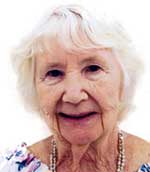 Highlights: Russian ballet – it was an evening we shall always remember – stone church in Finland, to see daylight at 10:30 PM was amazing, Catherine summer Palace was splendid. I was very pleased with the cleanliness of Finland, also people everywhere were so friendly. It was just great. Dorothy Farmer
Highlights: Russian ballet – it was an evening we shall always remember – stone church in Finland, to see daylight at 10:30 PM was amazing, Catherine summer Palace was splendid. I was very pleased with the cleanliness of Finland, also people everywhere were so friendly. It was just great. Dorothy Farmer I appreciated the lovely buffet breakfasts. I enjoyed your ability to herd cats. It was just fine – thank you. Don Farmer
I appreciated the lovely buffet breakfasts. I enjoyed your ability to herd cats. It was just fine – thank you. Don Farmer Overall the places Gerry and I experienced and saw were great. The methods of transportation were good, using public, trains, taxi, votes. Breakfast buffets on board ship, and in hotels were very good. If you like to walk – this is a good tour. John Young
Overall the places Gerry and I experienced and saw were great. The methods of transportation were good, using public, trains, taxi, votes. Breakfast buffets on board ship, and in hotels were very good. If you like to walk – this is a good tour. John Young Enjoyed being in the center of town, close to many sites and restaurants, etc. Enjoyed the walking tours. Gerry Young
Enjoyed being in the center of town, close to many sites and restaurants, etc. Enjoyed the walking tours. Gerry Young This was a memorable trip. I took 2300 photos. I am impressed with your background in art, architecture, history, etc., etc. – to see and hear your enthusiasm gets me excited as a traveler. It was wonderful traveling by various modes of transportation. I also enjoyed your full schedule and pace. My idea of a successful trip is to return home even more curious about the places just visited. These places we visited often piqued my imagination to research and learn more about them. So it was not unusual that the trip to St. Petersburg and Scandinavia stirred up a bunch of questions as well as newfound interests and thoughts. Thank you for a great time. Toby Kobatake
This was a memorable trip. I took 2300 photos. I am impressed with your background in art, architecture, history, etc., etc. – to see and hear your enthusiasm gets me excited as a traveler. It was wonderful traveling by various modes of transportation. I also enjoyed your full schedule and pace. My idea of a successful trip is to return home even more curious about the places just visited. These places we visited often piqued my imagination to research and learn more about them. So it was not unusual that the trip to St. Petersburg and Scandinavia stirred up a bunch of questions as well as newfound interests and thoughts. Thank you for a great time. Toby Kobatake Always the history and art. Great group of people to travel with. Enjoyed tapas in a restaurant by our hotel in Stockholm. Two great trip so far with you. You make us see what we should and need to see. Very good hotels. Hopefully South America next year. Barny Gomes
Always the history and art. Great group of people to travel with. Enjoyed tapas in a restaurant by our hotel in Stockholm. Two great trip so far with you. You make us see what we should and need to see. Very good hotels. Hopefully South America next year. Barny Gomes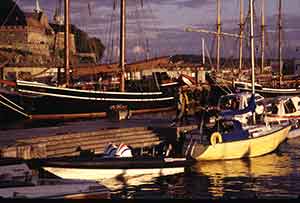



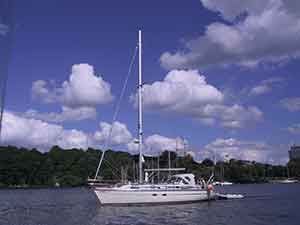




-06.jpg)
.jpg)
-06.jpg)
-04.jpg)

-04.jpg)
-06.jpg)
-06.jpg)
